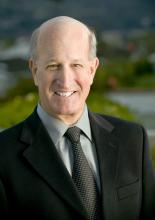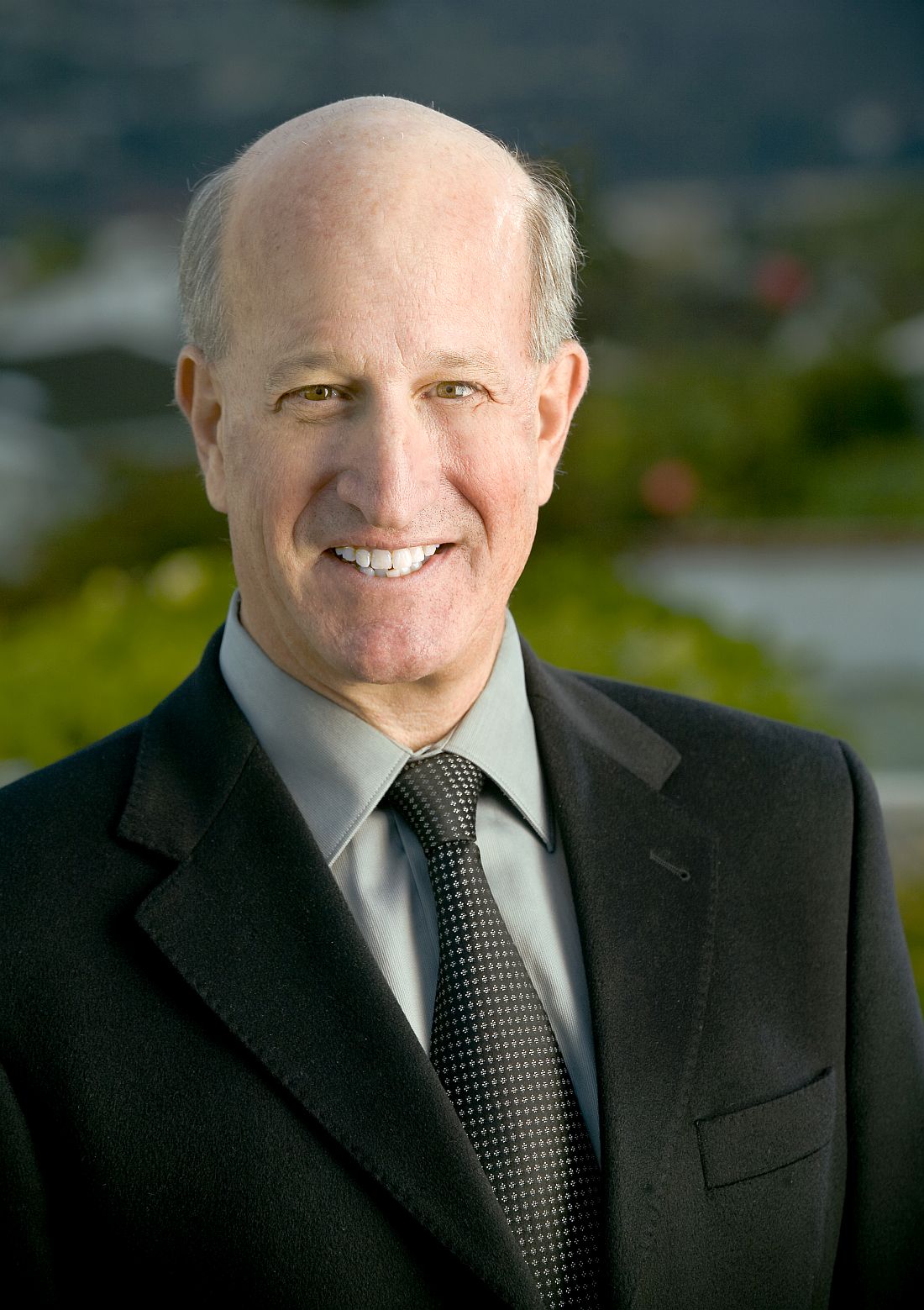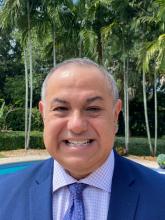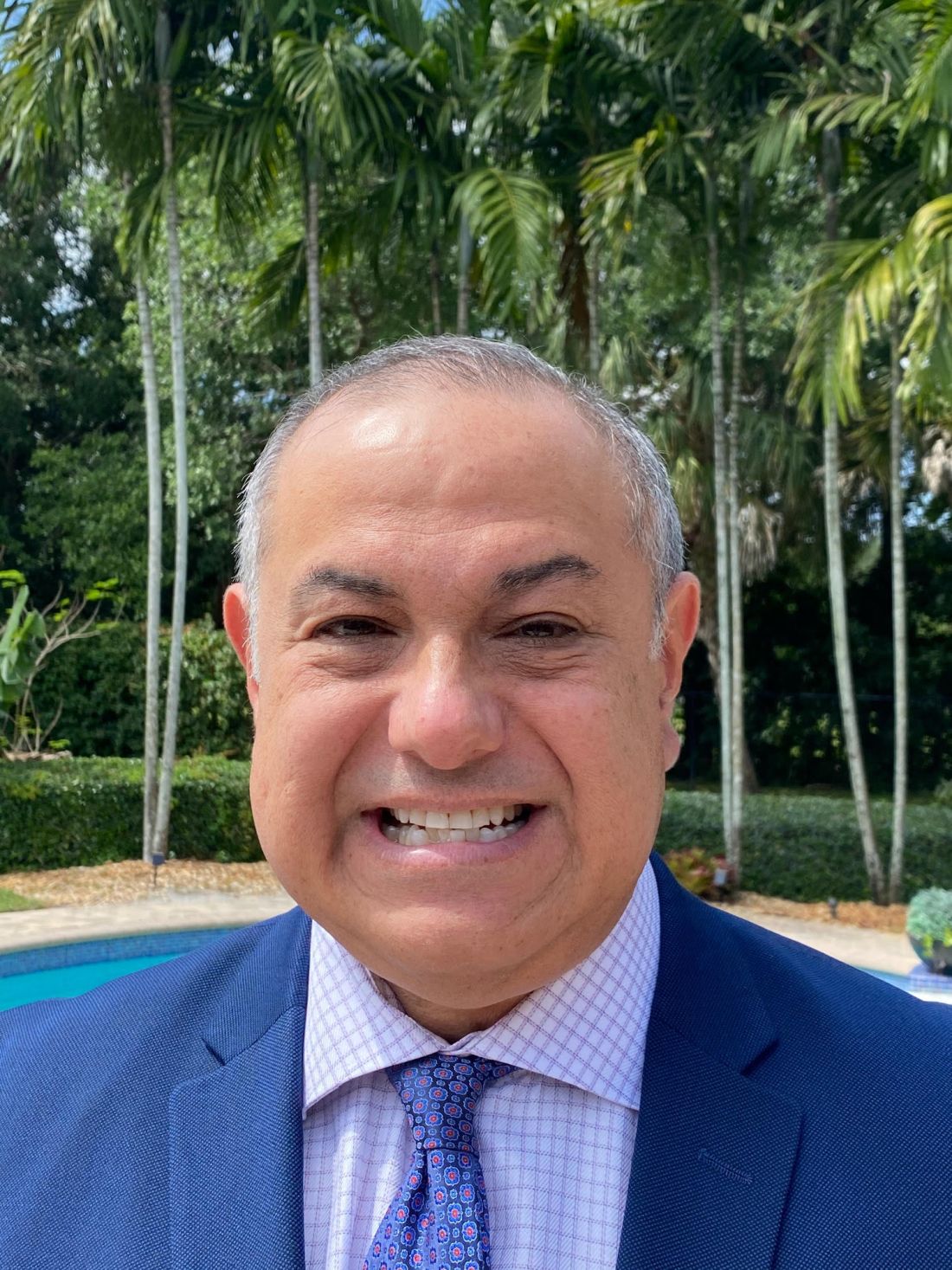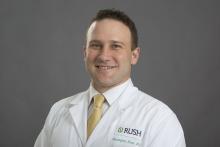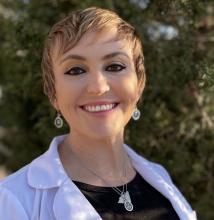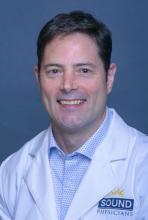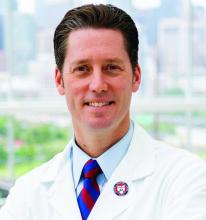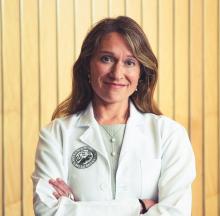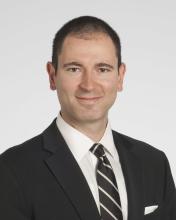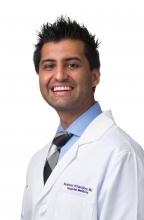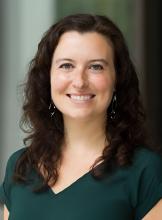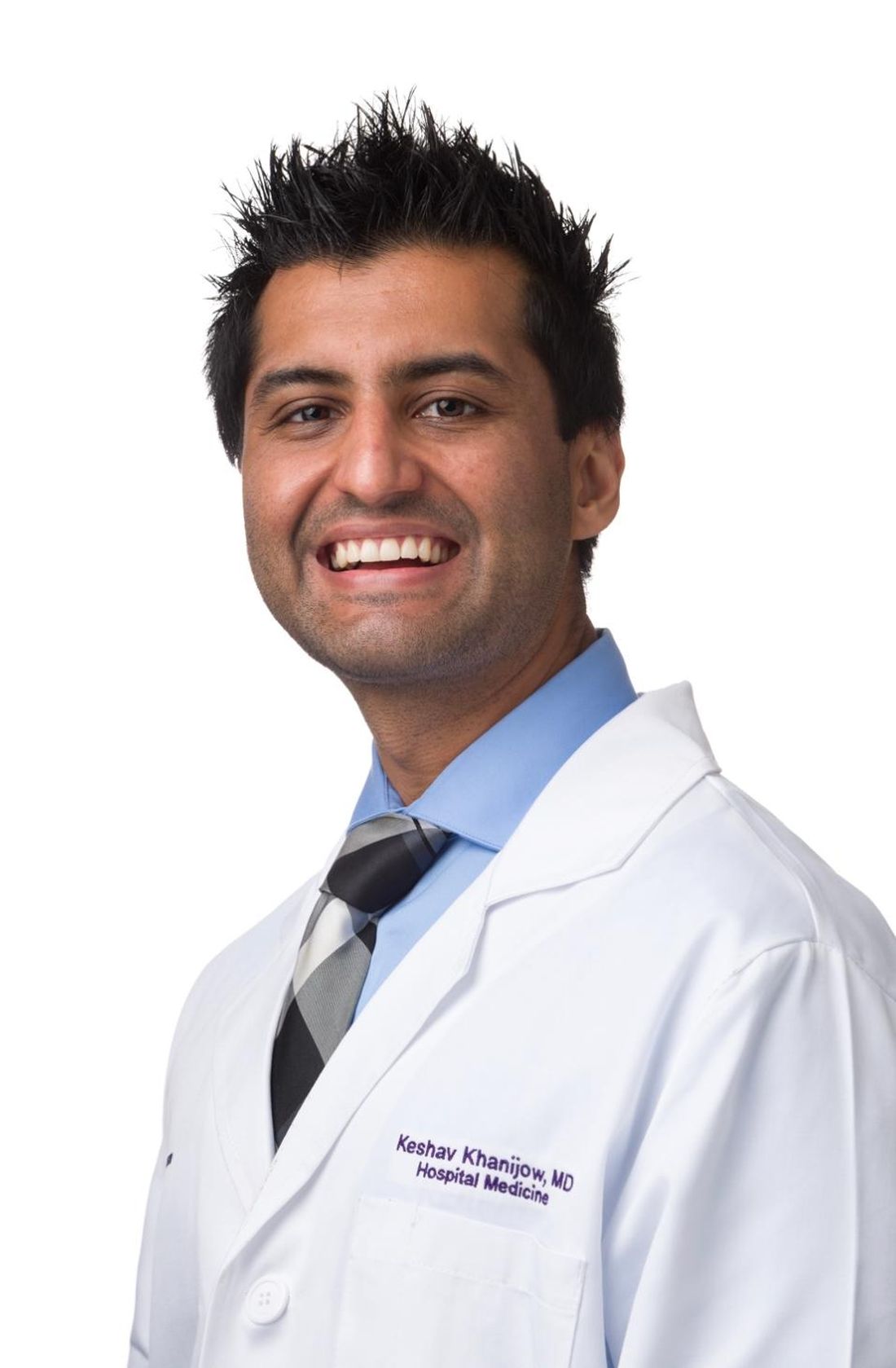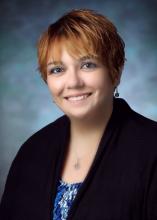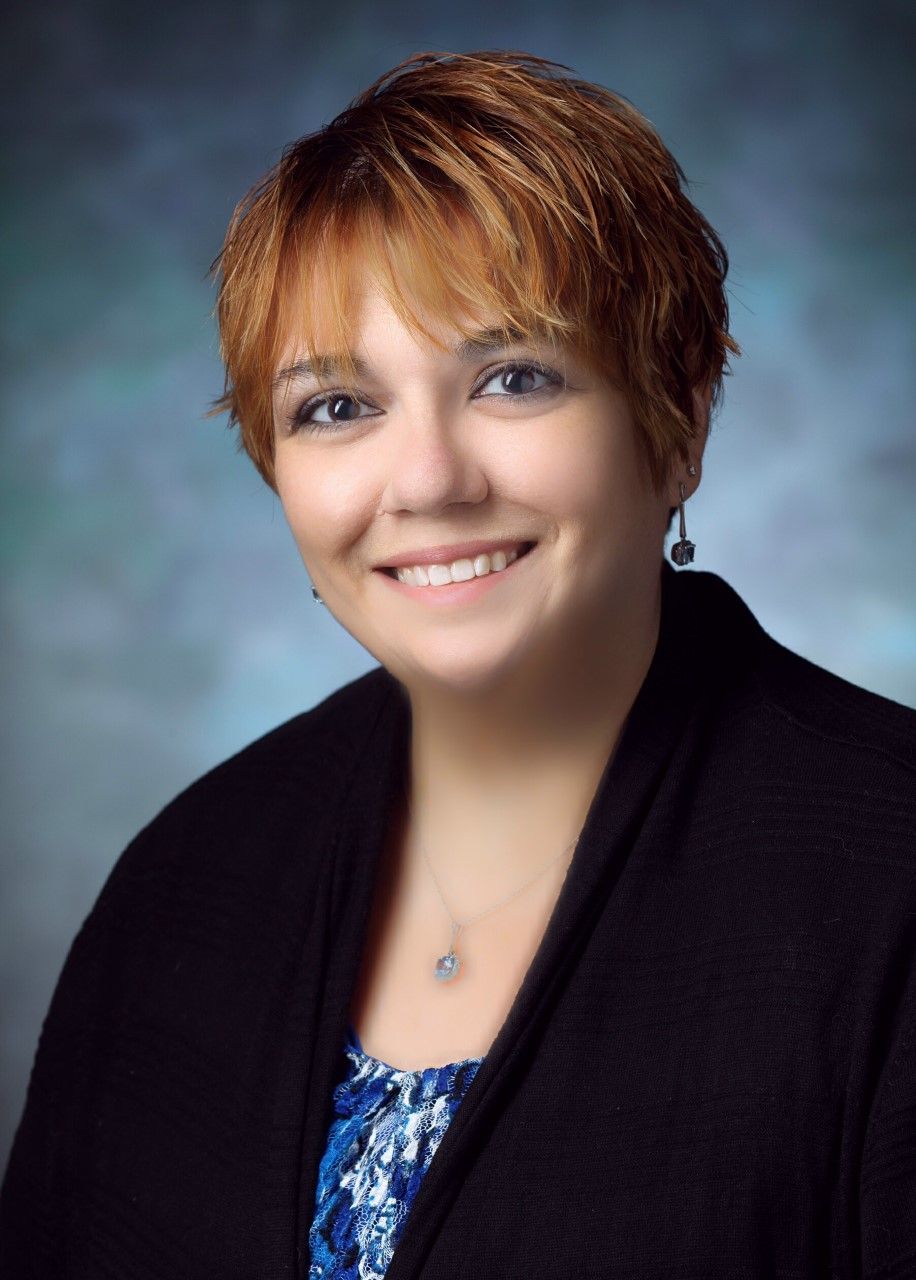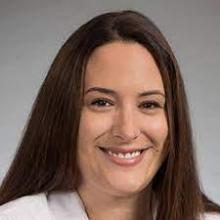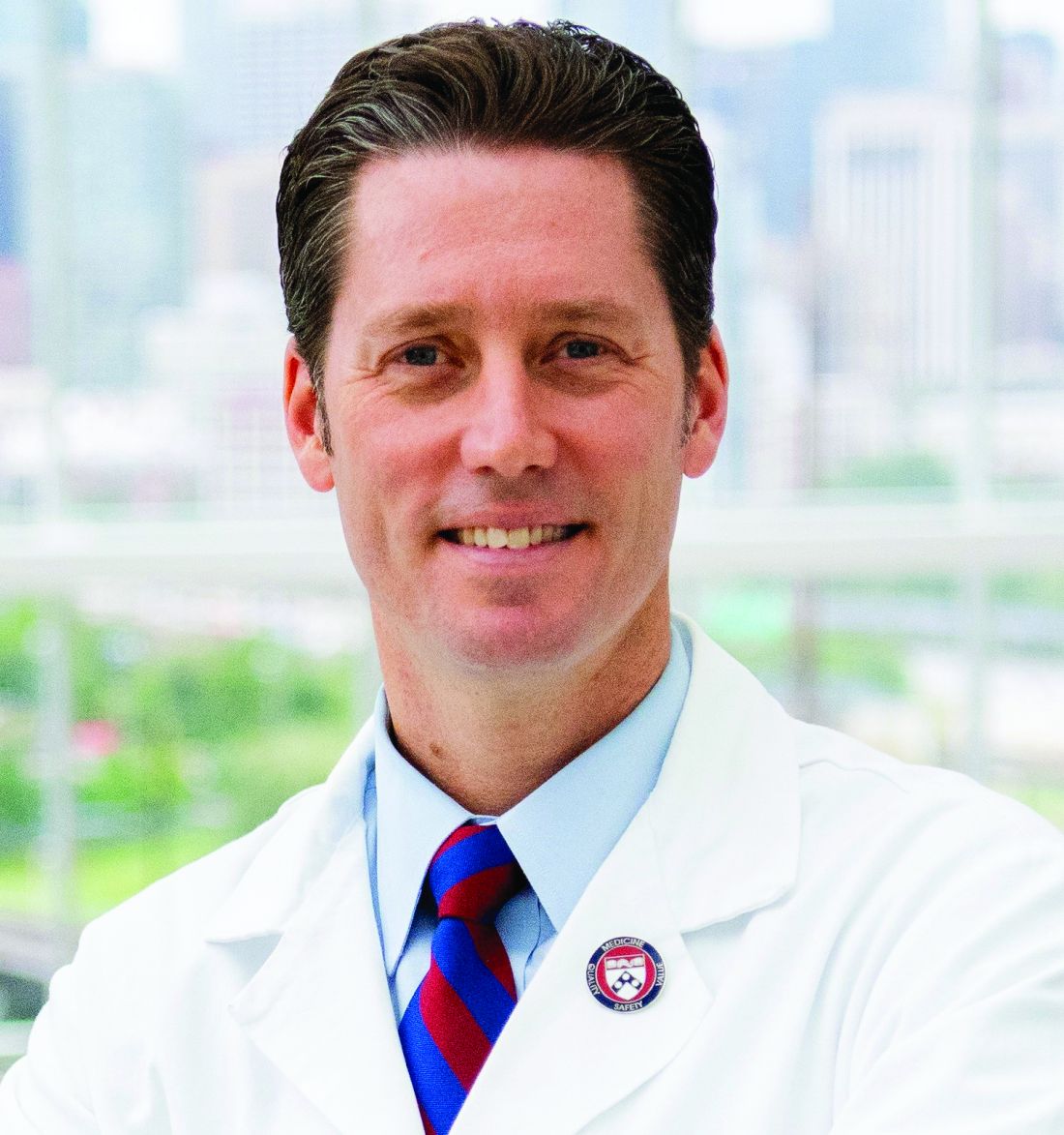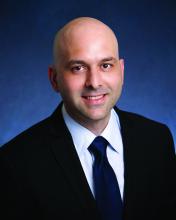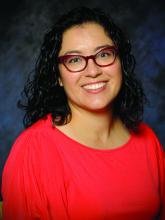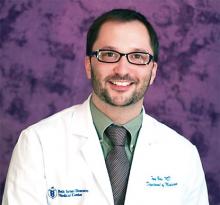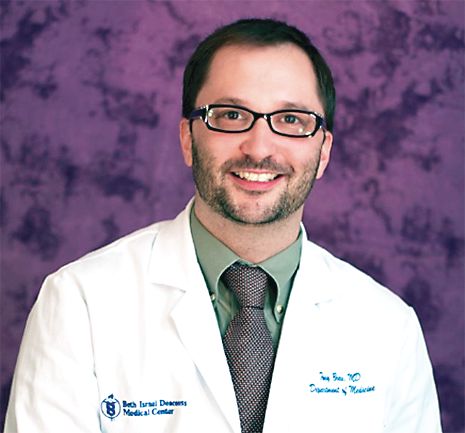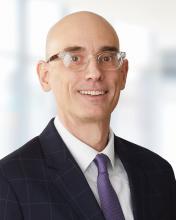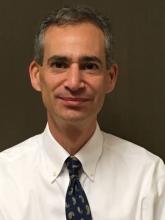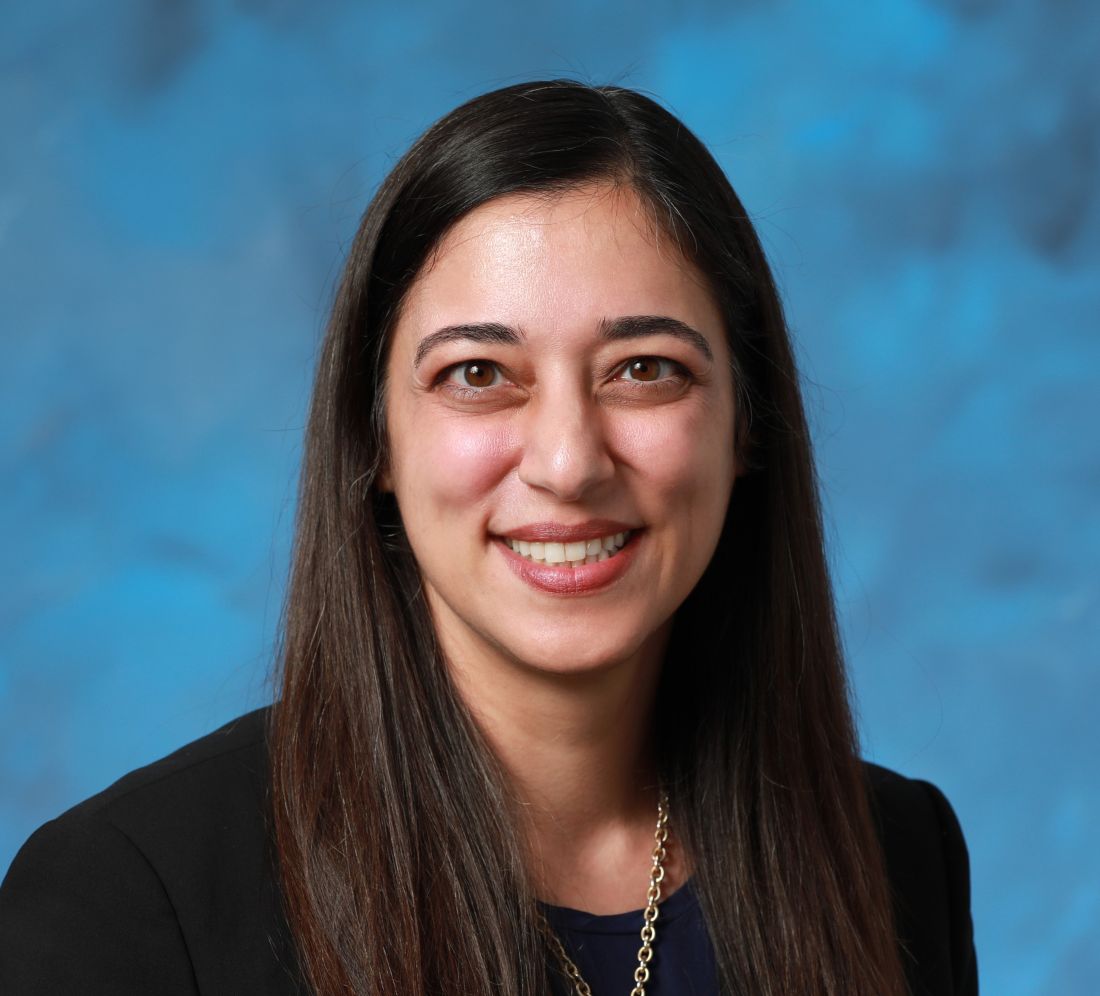User login
SHM Converge Daily News -- Day 3
Click here for the Friday issue of the SHM Converge Daily News newsletter.
Click here for the Friday issue of the SHM Converge Daily News newsletter.
Click here for the Friday issue of the SHM Converge Daily News newsletter.
COVID experience underscores ‘vital’ role of hospital medicine
While the COVID-19 pandemic has generated anxiety and confusion in medicine, one thing should bring a sense of clarity to hospitalists: They’re needed now more than ever.
Larry Wellikson, MD, MHM, the former, longtime CEO of the Society of Hospital Medicine, in a May 6 keynote speech at SHM Converge, the annual conference of the Society of Hospital Medicine, said the COVID-19 era has underscored the singular importance of the specialty.
“I think one thing that this recent pandemic has emphasized is just how important and vital hospitalists are to the United States’ health care system,” Dr. Wellikson said. “The response to the acute care needs in this pandemic would have been impossible in the health care system that existed before hospitalists. And so this is something that we should understand and appreciate.”
The “upheaval” experienced in hospital medicine continues a trend of change that will go on, both in the corporate health care landscape and in the role that hospitalists play in providing care, he said. Insurers have been merging and looking to consolidate. Hospital medicine companies have been merging, and “newfangled bedfellows” have been a trend, such as CVS stepping beyond its pharmacy role into an expanded health care role, Cigna buying Express Scripts, and an Amazon-Berkshire Hathaway-J.P. Morgan health care partnership that ultimately did not pan out, although that hasn’t ended Amazon’s presence in health care.
“You may not realize it, but Amazon is currently one of the largest hospital supply-chain companies,” Dr. Wellikson said. “They’re attempting to become a major pharmacy benefits manager and will only further enter into health care and into our personal and professional lives.”
New models of care point to the way of the future, he said. Mount Sinai’s continuing success with its Hospital at Home program – which involves an acute care nurse and team assigned to a patient in the home – introduces a concept that will be adopted more broadly, because of its cost savings and good outcomes, he said. Mergers of hospital systems, leading to excess hospital capacity, has given rise to what he calls “ED-plus,” or using formerly full-service hospitals as more focused centers – providing emergency, obstetrician, cardiology, x-ray, or orthopedics care, or whatever is needed in a given community.
An increasing focus on population health rather than procedures plays into the strengths of hospitalists, Dr. Wellikson said, and the need for their skills will continue to deepen.
When changes in reimbursement began about 4 years ago, specialties such as cardiology entered into new contracts with hospitals, but the facilities began to notice that many of the services – such as initial heart failure and chest pain management – can be provided by hospitalists.
“They’re signing fewer cardiologists and needing therefore to hire more hospitalists,” he said.
To keep readmissions low and subsequent costs down, hospitalists will continue to handle the first few postdischarge visits with patients, he said. This is crucial in bundled payment systems.
“Most of the savings in those systems comes from being very efficient in the initial postdischarge portion of people’s care,” Dr. Wellikson said.
At the same time, hospitalists are not in “unlimited supply.”
“I think every hospital medicine group should be assessing and working on improving their clinicians’ well-being,” he said. “We need to ration somewhat, so we’re deploying hospitalists for the things that only we can do.” He predicted that hospitalists will be required to work in the electronic medical record less frequently, with this task handled by others.
Dr. Wellikson also called on the specialty to continue to expand its racial and ethnic diversity so that it reflects the patient population it serves.
“We’re looking to create pathways to leadership for everyone and not just a tokenism moving forward,” he said.
The basic strengths of hospital medicine – its flexibility, professional culture, and youth – leave it well prepared for all of these changes, he said.
“There is a bright future and hospitalists are right in the middle of this – we’re not going to be marginalized or on the periphery,” Dr. Wellikson said. “If I had one message for all of you, I would say be relevant and add value and you will not only survive, but thrive.”
RIV winners announced
The winners of the 2021 RIV competition were also announced at the May 6 general session of Converge. There were two winners in each of the three categories, as follows:
RESEARCH
Overall: “Suboptimal Communication During Inter-Hospital Transfer,” Stephanie Mueller, MD, MPH, SFHM
Trainee: “Mentorship in Pediatric Hospital Medicine: A Survey of Division Directors,” Brandon Palmer, MD
INNOVATIONS
Overall: “Leveraging Artificial Intelligence for a Team-Based Approach to Advance Care Planning,” Ron Li, MD
Trainee: “A Trainee-Designed Initiative Reshapes Communication for Hospital Medicine Patients During COVID-19,” Smitha Ganeshan, MD, MBA
CLINICAL VIGNETTES
Adults: “Holy Spontaneous Heparin-Induced Thrombocytopenia,” Min Hwang
Pediatrics: “The Great Pretender: A Tale of Two Systems,” Shivani Desai, MD
While the COVID-19 pandemic has generated anxiety and confusion in medicine, one thing should bring a sense of clarity to hospitalists: They’re needed now more than ever.
Larry Wellikson, MD, MHM, the former, longtime CEO of the Society of Hospital Medicine, in a May 6 keynote speech at SHM Converge, the annual conference of the Society of Hospital Medicine, said the COVID-19 era has underscored the singular importance of the specialty.
“I think one thing that this recent pandemic has emphasized is just how important and vital hospitalists are to the United States’ health care system,” Dr. Wellikson said. “The response to the acute care needs in this pandemic would have been impossible in the health care system that existed before hospitalists. And so this is something that we should understand and appreciate.”
The “upheaval” experienced in hospital medicine continues a trend of change that will go on, both in the corporate health care landscape and in the role that hospitalists play in providing care, he said. Insurers have been merging and looking to consolidate. Hospital medicine companies have been merging, and “newfangled bedfellows” have been a trend, such as CVS stepping beyond its pharmacy role into an expanded health care role, Cigna buying Express Scripts, and an Amazon-Berkshire Hathaway-J.P. Morgan health care partnership that ultimately did not pan out, although that hasn’t ended Amazon’s presence in health care.
“You may not realize it, but Amazon is currently one of the largest hospital supply-chain companies,” Dr. Wellikson said. “They’re attempting to become a major pharmacy benefits manager and will only further enter into health care and into our personal and professional lives.”
New models of care point to the way of the future, he said. Mount Sinai’s continuing success with its Hospital at Home program – which involves an acute care nurse and team assigned to a patient in the home – introduces a concept that will be adopted more broadly, because of its cost savings and good outcomes, he said. Mergers of hospital systems, leading to excess hospital capacity, has given rise to what he calls “ED-plus,” or using formerly full-service hospitals as more focused centers – providing emergency, obstetrician, cardiology, x-ray, or orthopedics care, or whatever is needed in a given community.
An increasing focus on population health rather than procedures plays into the strengths of hospitalists, Dr. Wellikson said, and the need for their skills will continue to deepen.
When changes in reimbursement began about 4 years ago, specialties such as cardiology entered into new contracts with hospitals, but the facilities began to notice that many of the services – such as initial heart failure and chest pain management – can be provided by hospitalists.
“They’re signing fewer cardiologists and needing therefore to hire more hospitalists,” he said.
To keep readmissions low and subsequent costs down, hospitalists will continue to handle the first few postdischarge visits with patients, he said. This is crucial in bundled payment systems.
“Most of the savings in those systems comes from being very efficient in the initial postdischarge portion of people’s care,” Dr. Wellikson said.
At the same time, hospitalists are not in “unlimited supply.”
“I think every hospital medicine group should be assessing and working on improving their clinicians’ well-being,” he said. “We need to ration somewhat, so we’re deploying hospitalists for the things that only we can do.” He predicted that hospitalists will be required to work in the electronic medical record less frequently, with this task handled by others.
Dr. Wellikson also called on the specialty to continue to expand its racial and ethnic diversity so that it reflects the patient population it serves.
“We’re looking to create pathways to leadership for everyone and not just a tokenism moving forward,” he said.
The basic strengths of hospital medicine – its flexibility, professional culture, and youth – leave it well prepared for all of these changes, he said.
“There is a bright future and hospitalists are right in the middle of this – we’re not going to be marginalized or on the periphery,” Dr. Wellikson said. “If I had one message for all of you, I would say be relevant and add value and you will not only survive, but thrive.”
RIV winners announced
The winners of the 2021 RIV competition were also announced at the May 6 general session of Converge. There were two winners in each of the three categories, as follows:
RESEARCH
Overall: “Suboptimal Communication During Inter-Hospital Transfer,” Stephanie Mueller, MD, MPH, SFHM
Trainee: “Mentorship in Pediatric Hospital Medicine: A Survey of Division Directors,” Brandon Palmer, MD
INNOVATIONS
Overall: “Leveraging Artificial Intelligence for a Team-Based Approach to Advance Care Planning,” Ron Li, MD
Trainee: “A Trainee-Designed Initiative Reshapes Communication for Hospital Medicine Patients During COVID-19,” Smitha Ganeshan, MD, MBA
CLINICAL VIGNETTES
Adults: “Holy Spontaneous Heparin-Induced Thrombocytopenia,” Min Hwang
Pediatrics: “The Great Pretender: A Tale of Two Systems,” Shivani Desai, MD
While the COVID-19 pandemic has generated anxiety and confusion in medicine, one thing should bring a sense of clarity to hospitalists: They’re needed now more than ever.
Larry Wellikson, MD, MHM, the former, longtime CEO of the Society of Hospital Medicine, in a May 6 keynote speech at SHM Converge, the annual conference of the Society of Hospital Medicine, said the COVID-19 era has underscored the singular importance of the specialty.
“I think one thing that this recent pandemic has emphasized is just how important and vital hospitalists are to the United States’ health care system,” Dr. Wellikson said. “The response to the acute care needs in this pandemic would have been impossible in the health care system that existed before hospitalists. And so this is something that we should understand and appreciate.”
The “upheaval” experienced in hospital medicine continues a trend of change that will go on, both in the corporate health care landscape and in the role that hospitalists play in providing care, he said. Insurers have been merging and looking to consolidate. Hospital medicine companies have been merging, and “newfangled bedfellows” have been a trend, such as CVS stepping beyond its pharmacy role into an expanded health care role, Cigna buying Express Scripts, and an Amazon-Berkshire Hathaway-J.P. Morgan health care partnership that ultimately did not pan out, although that hasn’t ended Amazon’s presence in health care.
“You may not realize it, but Amazon is currently one of the largest hospital supply-chain companies,” Dr. Wellikson said. “They’re attempting to become a major pharmacy benefits manager and will only further enter into health care and into our personal and professional lives.”
New models of care point to the way of the future, he said. Mount Sinai’s continuing success with its Hospital at Home program – which involves an acute care nurse and team assigned to a patient in the home – introduces a concept that will be adopted more broadly, because of its cost savings and good outcomes, he said. Mergers of hospital systems, leading to excess hospital capacity, has given rise to what he calls “ED-plus,” or using formerly full-service hospitals as more focused centers – providing emergency, obstetrician, cardiology, x-ray, or orthopedics care, or whatever is needed in a given community.
An increasing focus on population health rather than procedures plays into the strengths of hospitalists, Dr. Wellikson said, and the need for their skills will continue to deepen.
When changes in reimbursement began about 4 years ago, specialties such as cardiology entered into new contracts with hospitals, but the facilities began to notice that many of the services – such as initial heart failure and chest pain management – can be provided by hospitalists.
“They’re signing fewer cardiologists and needing therefore to hire more hospitalists,” he said.
To keep readmissions low and subsequent costs down, hospitalists will continue to handle the first few postdischarge visits with patients, he said. This is crucial in bundled payment systems.
“Most of the savings in those systems comes from being very efficient in the initial postdischarge portion of people’s care,” Dr. Wellikson said.
At the same time, hospitalists are not in “unlimited supply.”
“I think every hospital medicine group should be assessing and working on improving their clinicians’ well-being,” he said. “We need to ration somewhat, so we’re deploying hospitalists for the things that only we can do.” He predicted that hospitalists will be required to work in the electronic medical record less frequently, with this task handled by others.
Dr. Wellikson also called on the specialty to continue to expand its racial and ethnic diversity so that it reflects the patient population it serves.
“We’re looking to create pathways to leadership for everyone and not just a tokenism moving forward,” he said.
The basic strengths of hospital medicine – its flexibility, professional culture, and youth – leave it well prepared for all of these changes, he said.
“There is a bright future and hospitalists are right in the middle of this – we’re not going to be marginalized or on the periphery,” Dr. Wellikson said. “If I had one message for all of you, I would say be relevant and add value and you will not only survive, but thrive.”
RIV winners announced
The winners of the 2021 RIV competition were also announced at the May 6 general session of Converge. There were two winners in each of the three categories, as follows:
RESEARCH
Overall: “Suboptimal Communication During Inter-Hospital Transfer,” Stephanie Mueller, MD, MPH, SFHM
Trainee: “Mentorship in Pediatric Hospital Medicine: A Survey of Division Directors,” Brandon Palmer, MD
INNOVATIONS
Overall: “Leveraging Artificial Intelligence for a Team-Based Approach to Advance Care Planning,” Ron Li, MD
Trainee: “A Trainee-Designed Initiative Reshapes Communication for Hospital Medicine Patients During COVID-19,” Smitha Ganeshan, MD, MBA
CLINICAL VIGNETTES
Adults: “Holy Spontaneous Heparin-Induced Thrombocytopenia,” Min Hwang
Pediatrics: “The Great Pretender: A Tale of Two Systems,” Shivani Desai, MD
FROM SHM CONVERGE 2021
Expert emphasizes importance of screening for OSA prior to surgery
If you don’t have a standardized process for obstructive sleep apnea screening of all patients heading into the operating room at your hospital you should, because perioperative pulmonary complications can occur, according to Efren C. Manjarrez MD, SFHM, FACP.
If OSA is not documented in the patient’s chart, you may find yourself making a bedside assessment. “I usually don’t ask the patients this because they can’t necessarily answer the questions,” Dr. Manjarrez, associate professor in the division of hospital medicine at the University of Miami, said at SHM Converge, the annual conference of the Society of Hospital Medicine. “So, I ask their partner: ‘Does your partner snore loudly? Are they sleepy during the daytime, or are they gasping or choking in the middle of the night?’”
The following factors have a relatively high specificity for OSA: a STOP-Bang score of 5 or greater, a STOP-Bang score of 2 or greater plus male gender, and a STOP-Bang score of 2 or greater plus a body mass index greater than 35 kg/m2. Clinicians can also check the Mallampati score on their patients by having them tilt their heads back and stick out their tongues.
“If the uvula is not touching the tongue, that’s a Mallampati score of 1; that’s a pretty wide-open airway,” Dr. Manjarrez said. “However, when you do not have any form of an airway and the palate is touching the tongue, that is a Mallampati score of 4, which indicates OSA.”
Other objective data suggestive of OSA include high blood pressure, a BMI over 35 kg/m2, a neck circumference of greater than 40 cm, and male gender. In a study of patients who presented for surgery who did not have a diagnosis of sleep apnea, a high STOP-Bang score indicated a high probability of moderate to severe sleep apnea (Br J. Anaesth 2012;108[5]:768-75).
“If the STOP-Bang score is 0-2, your workup stops,” Dr. Manjarrez said. “If your STOP-Bang score is 5 or above, there’s a high likelihood they have moderate or severe sleep apnea. Patients who have a STOP-Bang of 3-4, calculate their STOP score. If the STOP score is 2 or more and they’re male, obese, and have a neck circumference of greater than 40 cm, there’s a pretty good chance they’ve got OSA.”
Screening for OSA prior to surgery matters, because the potential pulmonary complications are fairly high, “anywhere from postoperative respiratory failure to COPD exacerbation and hypoxia to pneumonia,” he continued. “These patients very commonly desaturate and are difficult for the anesthesiologists to intubate. Fortunately, we have not found significant cardiac complications in the medical literature, but we do know that patients with OSA commonly get postoperative atrial fibrillation. There are also combined complications like desaturation and AFib and difficult intubations. Patients with sleep apnea do have a higher resource utilization perioperatively. Fortunately, at this point in time the data does not show that patients with OSA going in for surgery have an increased mortality.”
To optimize the care of these patients prior to surgery, Dr. Manjarrez recommends that hospitalists document that a patient either has known OSA or suspected OSA. “If possible, obtain their sleep study results and recommended PAP settings,” he said. “Ask patients to bring their PAP device to the hospital or to assure the hospital has appropriate surrogate devices available. You also want to advise the patient and the perioperative care team of the increased risk of complications in patients at high risk for OSA and optimize other conditions that may impair cardiorespiratory function.”
Perioperative risk reduction strategies include planning for difficult intubation and mask ventilation, using regional anesthesia and analgesia, using sedatives with caution, minimizing the use of opioids and anticipating variable opioid responses. “When I have a patient with suspected sleep apnea and no red flags I write down ‘OSA precautions,’ in the chart, which means elevate the head of the bed, perform continuous pulse oximetry, and cautiously supply supplemental oxygen as needed,” he said.
Postoperatively, he continued, minimize sedative agents and opioids, use regional and nonopioid analgesics when possible, provide supplemental oxygen until the patient is able to maintain baseline SaO2 on room air in a monitored setting, maintain the patient in nonsupine position when feasible, and continuously monitor pulse oximetry.
Consider delay of elective surgery and referral to a sleep medicine specialist in cases of uncontrolled systemic conditions or impaired gas exchange, including hypoventilation syndromes (a clue being a serum HC03 of 28 or higher), severe pulmonary hypertension (a clue being right ventricular systolic blood pressure or pulmonary systolic pressure of 70 mm Hg or above, or right ventricular dilatation/dysfunction), and hypoxemia not explained by cardiac disease.
A systematic review and meta-analysis of six studies that included 904 patients with sleep apnea found that there was no significant difference in the postoperative adverse events between CPAP and no-CPAP treatment (Anesth Analg 2015;120:1013-23). However, there was a significant reduction in the Apnea-Hypopnea Index postoperatively among those who used CPAP (37 vs. 12 events per hour; P less than .001), as well as a significant reduction in hospital length of stay 4 vs. 4.4 days; P = .05).
Dr. Manjarrez reported having no financial disclosures.
If you don’t have a standardized process for obstructive sleep apnea screening of all patients heading into the operating room at your hospital you should, because perioperative pulmonary complications can occur, according to Efren C. Manjarrez MD, SFHM, FACP.
If OSA is not documented in the patient’s chart, you may find yourself making a bedside assessment. “I usually don’t ask the patients this because they can’t necessarily answer the questions,” Dr. Manjarrez, associate professor in the division of hospital medicine at the University of Miami, said at SHM Converge, the annual conference of the Society of Hospital Medicine. “So, I ask their partner: ‘Does your partner snore loudly? Are they sleepy during the daytime, or are they gasping or choking in the middle of the night?’”
The following factors have a relatively high specificity for OSA: a STOP-Bang score of 5 or greater, a STOP-Bang score of 2 or greater plus male gender, and a STOP-Bang score of 2 or greater plus a body mass index greater than 35 kg/m2. Clinicians can also check the Mallampati score on their patients by having them tilt their heads back and stick out their tongues.
“If the uvula is not touching the tongue, that’s a Mallampati score of 1; that’s a pretty wide-open airway,” Dr. Manjarrez said. “However, when you do not have any form of an airway and the palate is touching the tongue, that is a Mallampati score of 4, which indicates OSA.”
Other objective data suggestive of OSA include high blood pressure, a BMI over 35 kg/m2, a neck circumference of greater than 40 cm, and male gender. In a study of patients who presented for surgery who did not have a diagnosis of sleep apnea, a high STOP-Bang score indicated a high probability of moderate to severe sleep apnea (Br J. Anaesth 2012;108[5]:768-75).
“If the STOP-Bang score is 0-2, your workup stops,” Dr. Manjarrez said. “If your STOP-Bang score is 5 or above, there’s a high likelihood they have moderate or severe sleep apnea. Patients who have a STOP-Bang of 3-4, calculate their STOP score. If the STOP score is 2 or more and they’re male, obese, and have a neck circumference of greater than 40 cm, there’s a pretty good chance they’ve got OSA.”
Screening for OSA prior to surgery matters, because the potential pulmonary complications are fairly high, “anywhere from postoperative respiratory failure to COPD exacerbation and hypoxia to pneumonia,” he continued. “These patients very commonly desaturate and are difficult for the anesthesiologists to intubate. Fortunately, we have not found significant cardiac complications in the medical literature, but we do know that patients with OSA commonly get postoperative atrial fibrillation. There are also combined complications like desaturation and AFib and difficult intubations. Patients with sleep apnea do have a higher resource utilization perioperatively. Fortunately, at this point in time the data does not show that patients with OSA going in for surgery have an increased mortality.”
To optimize the care of these patients prior to surgery, Dr. Manjarrez recommends that hospitalists document that a patient either has known OSA or suspected OSA. “If possible, obtain their sleep study results and recommended PAP settings,” he said. “Ask patients to bring their PAP device to the hospital or to assure the hospital has appropriate surrogate devices available. You also want to advise the patient and the perioperative care team of the increased risk of complications in patients at high risk for OSA and optimize other conditions that may impair cardiorespiratory function.”
Perioperative risk reduction strategies include planning for difficult intubation and mask ventilation, using regional anesthesia and analgesia, using sedatives with caution, minimizing the use of opioids and anticipating variable opioid responses. “When I have a patient with suspected sleep apnea and no red flags I write down ‘OSA precautions,’ in the chart, which means elevate the head of the bed, perform continuous pulse oximetry, and cautiously supply supplemental oxygen as needed,” he said.
Postoperatively, he continued, minimize sedative agents and opioids, use regional and nonopioid analgesics when possible, provide supplemental oxygen until the patient is able to maintain baseline SaO2 on room air in a monitored setting, maintain the patient in nonsupine position when feasible, and continuously monitor pulse oximetry.
Consider delay of elective surgery and referral to a sleep medicine specialist in cases of uncontrolled systemic conditions or impaired gas exchange, including hypoventilation syndromes (a clue being a serum HC03 of 28 or higher), severe pulmonary hypertension (a clue being right ventricular systolic blood pressure or pulmonary systolic pressure of 70 mm Hg or above, or right ventricular dilatation/dysfunction), and hypoxemia not explained by cardiac disease.
A systematic review and meta-analysis of six studies that included 904 patients with sleep apnea found that there was no significant difference in the postoperative adverse events between CPAP and no-CPAP treatment (Anesth Analg 2015;120:1013-23). However, there was a significant reduction in the Apnea-Hypopnea Index postoperatively among those who used CPAP (37 vs. 12 events per hour; P less than .001), as well as a significant reduction in hospital length of stay 4 vs. 4.4 days; P = .05).
Dr. Manjarrez reported having no financial disclosures.
If you don’t have a standardized process for obstructive sleep apnea screening of all patients heading into the operating room at your hospital you should, because perioperative pulmonary complications can occur, according to Efren C. Manjarrez MD, SFHM, FACP.
If OSA is not documented in the patient’s chart, you may find yourself making a bedside assessment. “I usually don’t ask the patients this because they can’t necessarily answer the questions,” Dr. Manjarrez, associate professor in the division of hospital medicine at the University of Miami, said at SHM Converge, the annual conference of the Society of Hospital Medicine. “So, I ask their partner: ‘Does your partner snore loudly? Are they sleepy during the daytime, or are they gasping or choking in the middle of the night?’”
The following factors have a relatively high specificity for OSA: a STOP-Bang score of 5 or greater, a STOP-Bang score of 2 or greater plus male gender, and a STOP-Bang score of 2 or greater plus a body mass index greater than 35 kg/m2. Clinicians can also check the Mallampati score on their patients by having them tilt their heads back and stick out their tongues.
“If the uvula is not touching the tongue, that’s a Mallampati score of 1; that’s a pretty wide-open airway,” Dr. Manjarrez said. “However, when you do not have any form of an airway and the palate is touching the tongue, that is a Mallampati score of 4, which indicates OSA.”
Other objective data suggestive of OSA include high blood pressure, a BMI over 35 kg/m2, a neck circumference of greater than 40 cm, and male gender. In a study of patients who presented for surgery who did not have a diagnosis of sleep apnea, a high STOP-Bang score indicated a high probability of moderate to severe sleep apnea (Br J. Anaesth 2012;108[5]:768-75).
“If the STOP-Bang score is 0-2, your workup stops,” Dr. Manjarrez said. “If your STOP-Bang score is 5 or above, there’s a high likelihood they have moderate or severe sleep apnea. Patients who have a STOP-Bang of 3-4, calculate their STOP score. If the STOP score is 2 or more and they’re male, obese, and have a neck circumference of greater than 40 cm, there’s a pretty good chance they’ve got OSA.”
Screening for OSA prior to surgery matters, because the potential pulmonary complications are fairly high, “anywhere from postoperative respiratory failure to COPD exacerbation and hypoxia to pneumonia,” he continued. “These patients very commonly desaturate and are difficult for the anesthesiologists to intubate. Fortunately, we have not found significant cardiac complications in the medical literature, but we do know that patients with OSA commonly get postoperative atrial fibrillation. There are also combined complications like desaturation and AFib and difficult intubations. Patients with sleep apnea do have a higher resource utilization perioperatively. Fortunately, at this point in time the data does not show that patients with OSA going in for surgery have an increased mortality.”
To optimize the care of these patients prior to surgery, Dr. Manjarrez recommends that hospitalists document that a patient either has known OSA or suspected OSA. “If possible, obtain their sleep study results and recommended PAP settings,” he said. “Ask patients to bring their PAP device to the hospital or to assure the hospital has appropriate surrogate devices available. You also want to advise the patient and the perioperative care team of the increased risk of complications in patients at high risk for OSA and optimize other conditions that may impair cardiorespiratory function.”
Perioperative risk reduction strategies include planning for difficult intubation and mask ventilation, using regional anesthesia and analgesia, using sedatives with caution, minimizing the use of opioids and anticipating variable opioid responses. “When I have a patient with suspected sleep apnea and no red flags I write down ‘OSA precautions,’ in the chart, which means elevate the head of the bed, perform continuous pulse oximetry, and cautiously supply supplemental oxygen as needed,” he said.
Postoperatively, he continued, minimize sedative agents and opioids, use regional and nonopioid analgesics when possible, provide supplemental oxygen until the patient is able to maintain baseline SaO2 on room air in a monitored setting, maintain the patient in nonsupine position when feasible, and continuously monitor pulse oximetry.
Consider delay of elective surgery and referral to a sleep medicine specialist in cases of uncontrolled systemic conditions or impaired gas exchange, including hypoventilation syndromes (a clue being a serum HC03 of 28 or higher), severe pulmonary hypertension (a clue being right ventricular systolic blood pressure or pulmonary systolic pressure of 70 mm Hg or above, or right ventricular dilatation/dysfunction), and hypoxemia not explained by cardiac disease.
A systematic review and meta-analysis of six studies that included 904 patients with sleep apnea found that there was no significant difference in the postoperative adverse events between CPAP and no-CPAP treatment (Anesth Analg 2015;120:1013-23). However, there was a significant reduction in the Apnea-Hypopnea Index postoperatively among those who used CPAP (37 vs. 12 events per hour; P less than .001), as well as a significant reduction in hospital length of stay 4 vs. 4.4 days; P = .05).
Dr. Manjarrez reported having no financial disclosures.
FROM SHM CONVERGE 2021
SHM 2021 Awards of Excellence and Junior Investigator Awards
Clinical Leadership for Physicians
Christopher P. Bruti, MD, MPH
Dr. Christopher P. Bruti is the division chief of hospital medicine at Rush University and the program director of Rush’s combined Internal Medicine–Pediatrics Residency Program. He is an associate professor of internal medicine and pediatrics and practices as a hospitalist in both departments.
Dr. Bruti always rises to any challenge that comes his way with empathetic, organized, and insightful leadership. Dr. Bruti is known for his innovation in patient care and optimization practices in the hospital setting – from expanding and optimizing the nonteaching service and a high-functioning observation unit to geolocalization and reorganization of medical teams. While his reputation as a leader was well established before the pandemic hit, the way he rose to the many challenges over the past year has been truly remarkable. After he identified one of the first cases of COVID-19 in his hospital, Dr. Bruti’s leadership was evident. He ensured that his staff was wearing proper PPE, reorganized hospitalist staffing, coordinated onboarding of subspecialists, developed algorithms around testing, and created safety-driven patient transfer strategies.
He is a member of the Rush University Medical Center Medical Executive Committee and is the chair of its Medical Records Committee. He has been recognized by both Internal Medicine and Pediatrics clerkships multiple times for excellence in teaching.
Dr. Bruti became a member of SHM in 2014 and has been extremely active with the Chicago chapter. He has also served on the Quality Improvement and Pediatric Medicine Special Interest Groups.
Clinical Leadership for NPs & PAs
Krystle D. Apodaca, DNP, FHM
Dr. Krystle D. Apodaca is a nurse practitioner hospitalist at the University of New Mexico Hospital, where she is assistant professor of medicine within the university’s Clinician Education Track.
She was one of the first APPs welcomed into the UNM Hospital Medicine division and has been integral not only in the development of UNM’s APP program, but also its APP Hospital Medicine Fellowship, which she helped to cofound. She is a member of the UNM Hospital Medicine Executive Committee as well as its LGBTQ Collaborative.
She is known for her leadership within Project ECHO at UNM, a worldwide program focused on democratizing medical knowledge. She is the co–medical director of its National Nursing Home COVID-19 Safety and Medicaid Quality Improvement Hospitalization Avoidance efforts, both focused on improving nursing home practices. This program, in partnership with the Agency for Healthcare Research and Quality, UNM’s ECHO Institute, and the Institute for Healthcare Improvement, is now a national initiative dedicated to standardizing COVID-19 best practices at nursing homes across the country. To achieve its goals, more than 15,000 nursing homes have been certified and a community of more than 250 training centers has been built through Project ECHO.
Dr. Apodaca has been a member of SHM since 2015. She has been an active member of SHM’s NP/PA Special Interest Group since she joined and was appointed as the first APP president of SHM’s New Mexico chapter in April 2020. Under her leadership, the chapter achieved Gold and Platinum status as well as the Chapter of the Year Award. She is also a Fellow in Hospital Medicine.
Certificate of Leadership in Hospital Medicine
Mihir Patel, MD, MBA, MPH, CLHM, SFHM
The Certificate of Leadership in Hospital Medicine (CLHM) cultivates leadership skills in the context of specific hospital medicine challenges. This designation informs employers – or potential employers – with confidence that a candidate is equipped and ready to lead teams and grow an organization.
Dr. Mihir Patel serves as medical director of virtual medicine and a full-time hospitalist at Ballad Health in Johnson City, Tenn. He also works part time as a telehospitalist with Sound Physicians, covering multiple hospitals in California and Washington State. He has previously served in a number of administrative roles including medical director of hospitalist program, chief of staff, and director of medical informatics committee, in addition to working as hospitalist in both rural and urban hospitals. He is cofounder and president of the Blue Ridge Chapter of the Society of Hospital Medicine.
Dr. Mihir’s research and clinical interests focus on integration of telemedicine, electronic medical records, and principles of lean healthcare to reduce waste and cost of care while improving overall quality and safety.
Humanitarian Services
Eileen Barrett, MD, MPH, MACP, SFHM
Dr. Eileen Barrett is an internal medicine hospitalist at the University of New Mexico, where she also serves as associate professor of medicine and the director of Continuing Medical Education in the Office of Continuous Professional Learning.
In addition to current clinical and educational roles at UNM, Dr. Barrett has extensive leadership experience as the former director of Graduate Medical Education Wellness Initiatives, the current District 10 Chair of SHM, as chair of a multiorganizational Diversity Equity and Inclusion (DEI) Collaborative Task Force, and as a former regent of the American College of Physicians.
Her tremendous efforts in humanitarian services are reflected in her dedication to supporting communities in need. In 2015, Dr. Barrett traveled to Sierra Leone, where she served as an Ebola response clinician. There, she helped to develop safer care protocols, including initiating morning huddles, standardizing onboarding, and improving medication administration and documentation. These skills were developed while she worked for the Navajo Area Indian Health Service (including as an infection control consultant) for more than 9 years and in volunteering at the Myanmar-Thai border with refugees. Her work abroad helped support her training for directing UNM hospitalist COVID-19 Operations while also providing direct care.
Dr. Barrett has represented the specialty of hospital medicine both nationally and internationally. She has served on national committees and spoken from the perspective of an academic and community hospitalist leader on issues such as performance management, patient engagement, DEI, and professional fulfillment.
She has been a member of SHM since 2014 and has served as cochair of the three most recent Innovations Poster Competitions. Dr. Barrett is a former president of SHM’s New Mexico chapter where under her leadership the chapter received SHM’s Outstanding Chapter Award in 2018. She is a dedicated member of SHM’s Physicians in Training Committee and Chapter Support Committee. Dr. Barrett is an elected member of the Gold Humanism Honor Society, received a 2019 Exemplary Mentor Award from the American Medical Women’s Association, and is a Senior Fellow in Hospital Medicine.
Leadership for Practice Management
Leah Lleras, MS
Leah Lleras is the division administrator for the University of Colorado, Anschutz Medical Campus, and holds a Master of Science Management and Organization degree from the University of Colorado.
Her leadership as a practice manager is exemplified through her efforts in challenges of salary inequity. After joining the Division of Hospital Medicine in 2018, Ms. Lleras was successful in launching and achieving compensation equity and transparency across the department. She has demonstrated an incredible ability to collaborate with clinical leadership to marry the vision of clinical leaders with the administrative support required to turn a vision into a reality. During the COVID-19 pandemic, Ms. Lleras has been instrumental in ensuring that the division was prepared and supported to care for an influx of new patients. She did this by leading emergent onboarding of new practitioners, strategizing financial management of hazard pay for frontline clinicians, and creating a streamlined budget system during rapid change.
Ms. Lleras joined the Society in 2018 and has been an active member of the Rocky Mountain Chapter and the Hospital Medicine Administrator Special Interest Group.
Outstanding Service
Robert Zipper, MD, MMM, SFHM
Dr. Robert Zipper is a physician advisor and senior policy advisor for Sound Physicians, with more than 20 years of clinical experience as a hospital medicine leader.
He has a diverse background in quality and patient safety, hospitalist program design, and performance management. He began working as a hospitalist in 1999, in private practice. In 2006, he launched his career at Sound, where he began as a hospitalist but eventually managed Sound’s West Coast programs. In 2017, he was appointed Sound vice president of innovation technology. He later became Sound’s leader for healthcare policy, and now serves as a senior policy advisor for Sound, and physician advisor within the Advisory Services line.
Dr. Zipper has been a longtime supporter and advocate of SHM and the field of hospital medicine since joining in 2005. He attended his first Leadership Academy in 2006 and went on to serve as facilitator four times. His passion for SHM’s conferences is evident, as he has presented at three Annual Conferences alongside notable SHM leaders. He has been active in a variety of committees, including Quality and Safety, Leadership, and Performance Measurement and Reporting.
He is a member of the Society’s Public Policy Committee, and his insight has elevated hospital medicine both in the eyes of peer specialties and in discussions with the Centers for Medicare and Medicaid Services. Dr. Zipper has joined a number of calls with key Capitol Hill and CMS staff to help advocate for issues affecting hospital medicine. His ability to explain issues clearly and eloquently has helped stakeholders better understand the issues and move them forward on lawmakers’ agendas.
Research
S. Ryan Greysen, MD, MHS, SFHM
Dr. S. Ryan Greysen is chief of the Section of Hospital Medicine and associate professor at the University of Pennsylvania. He is the executive director for the Center for Evidence-based Practice (CEP) which serves all hospitals in the University of Pennsylvania Health System.
Dr. Greysen’s work comprises more than 80 peer-reviewed publications focused on improving outcomes of care for older adults during and after acute illness. Prior to arriving at Penn, he practiced at the University of California, San Francisco, where the impact of his work was extremely visible on the wards. He helped implement care pathways for an Acute Care for Elders (ACE) unit that uses evidence-based protocols and order sets to prevent functional decline and delirium of vulnerable seniors.
At Penn, he has continued to champion care for seniors and has supported other successful programs focused on vulnerable populations: SOAR (Supporting Older Adults at Risk), STEP (Supporting Transitions and Empowering Patients), and MED (Mental health Engagement navigation & Delivery).
During the COVID-19 pandemic, Dr. Greysen helped to accelerate the synthesis of emerging evidence through CEP and the Hospital Medicine Re-engineering Network (HOMERuN) to produce rapid evidence summaries in record speed. These reports have been broadly disseminated across other networks, such as AHRQ and the VA Evidence Synthesis Program.
Since joining the Society 10 years ago, Dr. Greysen has been an engaged member of SHM’s Greater Philadelphia Chapter and has held leadership roles on SHM’s Research Committee and the JHM Editorial Team as an associate editor. He has presented at multiple SHM annual conferences and is an ambassador of the specialty and of the importance of research in hospital medicine.
He is a Senior Fellow in Hospital Medicine.
Teaching
Grace C. Huang, MD
Dr. Grace C. Huang is an educator and hospitalist at Beth Israel Deaconess Medical Center and associate professor of medicine at Harvard Medical School who epitomizes commitment to education and lifelong learning.
Dr. Huang’s nationally recognized hospitalist expertise spans medical education and innovation, administrative management, and editorial leadership. She was among the early hospitalist pioneers who helped to transform how residents were trained to do procedures. Her early work led to the creation of one of the first procedure rotations for residents in the country – an RCT on central line simulation, the validation of a central line placement instrument, and a systematic review on procedural training for nonsurgeons.
Dr. Huang is vice chair for career development and mentoring in the department of medicine and oversees faculty development at the institutional level. She leads a Harvard Medical School–wide medical education fellowship for faculty and codirects the BIDMC Academy. On a broader scale, her efforts in the field have helped to catalyze the growth of computer-based simulation, define new standards for critical thinking education, and influence high-value care and invasive bedside procedure teaching approaches. Finally, she is editor-in-chief of MedEdPORTAL, an innovative journal of the Association of American Medical Colleges that publishes and disseminates educational resources.
Dr. Huang has been awarded the Gordon J. Strewler Mentoring of Resident Research Award in 2018, the Robert Stone Award for Excellence in Teaching Award, and most recently the A. Clifford Barger Excellence in Mentoring Award at Harvard Medical School, among many others. She is an editorial board member of Academic Medicine.
Dr. Huang joined SHM in 2010. Since then, she has been an engaged member of the Boston Chapter and has regularly participated in SHM’s annual conferences. She was also a member of SHM’s Practice Analysis Committee for 7 years.
Teamwork in Quality Improvement
Intermountain Healthcare
Intermountain Healthcare is a not-for-profit health system based in Salt Lake City serving the needs of patients primarily in Utah, Idaho, and Nevada. Intermountain recently reimagined its leadership structure with an integrated approach focused on developing and implementing common goals across its 23-hospital healthcare system, which was previously divided into regions. With key focus areas including communication, best practices, and goal setting, this structure has helped to combat former fragmentation struggles by creating an environment that provides a consistent high-level care experience regardless of the treatment center a patient selects.
With this reorganization came improved structure allowing for a unique team-based approach while still promoting clear communication lines across the 23 hospitals. This innovative Med/Surg Operations Lane allowed for flexible adaptation to the rapidly changing landscape of the COVID-19 pandemic. Intermountain Healthcare utilized its new framework to ensure crisis-ready operations by defining best practices through real-time literature review and teaming with ED, ICU, and Nursing to create COVID-19 workflows, order sets, and dashboards. Capacity issues were addressed with a variety of strategies: (1) daily systemwide huddles to facilitate load leveling between hospitals; (2) the use of telehealth for early discharges; and (3) remote patient monitoring and admission to the “Intermountain at Home” program, which preserved the ability to deliver critical surgical services.
This new value model clearly sets Intermountain apart from its peers.
Diversity
Lilia Cervantes, MD
Dr. Lilia Cervantes is associate professor in the department of medicine at Denver Health Medical Center and the University of Colorado, where she demonstrates an unparalleled commitment to diversity through her patient care, community service efforts, research, and health policy activism.
Following her internal medicine residency at the University of Colorado in 2008, Dr. Cervantes went on to obtain her master of science degree in clinical science, and became associate professor of medicine and a hospitalist at Denver Health Medical Center. In addition to her patient-centric roles at Denver Health, Dr. Cervantes has held a variety of roles in the health equity space. These include founding Denver Health Medical Center’s Health Equity Learning Series and the Healthcare Interest Program, a pre–health pipeline program for undergraduate students interested in a healthcare career.
Dr. Cervantes attributes her passion for becoming a physician to her background as a bilingual Latina who grew up in poverty. She says that her upbringing allows her to use this unique lens to connect with her diverse patient population and to advocate for marginalized communities and eliminate structural inequities.
Her experience with Hilda, an undocumented immigrant with kidney failure, was the catalyst for further research on marginalized patients without access to healthcare, which earned her interviews with NPR and CNN’s Chief Health Correspondent Dr. Sanjay Gupta. Her research and advocacy led to Colorado Medicaid’s expanding access to scheduled dialysis for undocumented immigrants with kidney failure. Upon announcement of the change, Dr. Cervantes was recognized as the driving force whose research informed the decision.
During the COVID-19 pandemic, Dr. Cervantes has worked diligently to launch research projects and create grant-funded programs to reduce the disproportionate burden of COVID-19 cases and deaths in the Latinx community in Denver. One of her studies centers on the Latinx community – through qualitative interviews of Latinx who had survived a COVID-19 hospitalization, Dr. Cervantes learned about the challenges faced during the pandemic. These findings informed local and national interventions to reduce COVID-19 in the Latinx community.
She has received numerous accolades, including the inaugural Outstanding Service to the Community in 2019 by Denver Health, the Florence Rena Sabin Award from the University of Colorado, and awards from the community – Health Equity Champion Award from the Center for Health Progress and the Unsung Heroine Award from the Latina First Foundation. She serves on several boards including two community-based organizations – the Center for Health Progress and Vuela for Health.
Dr. Cervantes has been an active member of SHM since 2009 and served as keynote speaker for the annual “Summit of the Rockies” Rocky Mountain Chapter SHM conference, “The role of advocacy: Moving the needle towards health equity.”
Junior Investigator Award
Matthew Pappas, MD, MPH, FHM
Dr. Matthew Pappas is a staff physician at the Cleveland Clinic, where he serves as assistant professor at the Lerner College of Medicine and Research Investigator at the Center for Value-Based Care Research.
Dr. Pappas completed his residency at the University of Michigan Health System and a postdoctoral fellowship with the VA Ann Arbor Healthcare System in 2016. Currently a hospitalist, he believes in addressing the tension between evidence-based and personal decisions, a fundamental hypothesis of his research career. As a Fellow, he created a model to predict the benefit of bridging anticoagulation for patients with atrial fibrillation. He sees his research mission as addressing the importance of these balanced decisions.
In 2019, Dr. Pappas secured a K08 award from the National Heart, Lung, and Blood Institute, and has turned his attention to preoperative cardiac testing and perioperative outcomes. He has published two manuscripts from this project, with a robust pipeline of others in progress.
He was recognized for his research by the Society of General Internal Medicine in 2018 with the Hamolsky Award for best abstract and had one of his research articles included in the Top 10 Articles of 2019 by the Journal of Hospital Medicine. Dr. Pappas has ongoing research support from the National Heart, Lung and Blood Institute.
He has been a member of SHM since 2015 and currently serves on the Perioperative Special Interest Group and Research Committee.
Clinical Leadership for Physicians
Christopher P. Bruti, MD, MPH
Dr. Christopher P. Bruti is the division chief of hospital medicine at Rush University and the program director of Rush’s combined Internal Medicine–Pediatrics Residency Program. He is an associate professor of internal medicine and pediatrics and practices as a hospitalist in both departments.
Dr. Bruti always rises to any challenge that comes his way with empathetic, organized, and insightful leadership. Dr. Bruti is known for his innovation in patient care and optimization practices in the hospital setting – from expanding and optimizing the nonteaching service and a high-functioning observation unit to geolocalization and reorganization of medical teams. While his reputation as a leader was well established before the pandemic hit, the way he rose to the many challenges over the past year has been truly remarkable. After he identified one of the first cases of COVID-19 in his hospital, Dr. Bruti’s leadership was evident. He ensured that his staff was wearing proper PPE, reorganized hospitalist staffing, coordinated onboarding of subspecialists, developed algorithms around testing, and created safety-driven patient transfer strategies.
He is a member of the Rush University Medical Center Medical Executive Committee and is the chair of its Medical Records Committee. He has been recognized by both Internal Medicine and Pediatrics clerkships multiple times for excellence in teaching.
Dr. Bruti became a member of SHM in 2014 and has been extremely active with the Chicago chapter. He has also served on the Quality Improvement and Pediatric Medicine Special Interest Groups.
Clinical Leadership for NPs & PAs
Krystle D. Apodaca, DNP, FHM
Dr. Krystle D. Apodaca is a nurse practitioner hospitalist at the University of New Mexico Hospital, where she is assistant professor of medicine within the university’s Clinician Education Track.
She was one of the first APPs welcomed into the UNM Hospital Medicine division and has been integral not only in the development of UNM’s APP program, but also its APP Hospital Medicine Fellowship, which she helped to cofound. She is a member of the UNM Hospital Medicine Executive Committee as well as its LGBTQ Collaborative.
She is known for her leadership within Project ECHO at UNM, a worldwide program focused on democratizing medical knowledge. She is the co–medical director of its National Nursing Home COVID-19 Safety and Medicaid Quality Improvement Hospitalization Avoidance efforts, both focused on improving nursing home practices. This program, in partnership with the Agency for Healthcare Research and Quality, UNM’s ECHO Institute, and the Institute for Healthcare Improvement, is now a national initiative dedicated to standardizing COVID-19 best practices at nursing homes across the country. To achieve its goals, more than 15,000 nursing homes have been certified and a community of more than 250 training centers has been built through Project ECHO.
Dr. Apodaca has been a member of SHM since 2015. She has been an active member of SHM’s NP/PA Special Interest Group since she joined and was appointed as the first APP president of SHM’s New Mexico chapter in April 2020. Under her leadership, the chapter achieved Gold and Platinum status as well as the Chapter of the Year Award. She is also a Fellow in Hospital Medicine.
Certificate of Leadership in Hospital Medicine
Mihir Patel, MD, MBA, MPH, CLHM, SFHM
The Certificate of Leadership in Hospital Medicine (CLHM) cultivates leadership skills in the context of specific hospital medicine challenges. This designation informs employers – or potential employers – with confidence that a candidate is equipped and ready to lead teams and grow an organization.
Dr. Mihir Patel serves as medical director of virtual medicine and a full-time hospitalist at Ballad Health in Johnson City, Tenn. He also works part time as a telehospitalist with Sound Physicians, covering multiple hospitals in California and Washington State. He has previously served in a number of administrative roles including medical director of hospitalist program, chief of staff, and director of medical informatics committee, in addition to working as hospitalist in both rural and urban hospitals. He is cofounder and president of the Blue Ridge Chapter of the Society of Hospital Medicine.
Dr. Mihir’s research and clinical interests focus on integration of telemedicine, electronic medical records, and principles of lean healthcare to reduce waste and cost of care while improving overall quality and safety.
Humanitarian Services
Eileen Barrett, MD, MPH, MACP, SFHM
Dr. Eileen Barrett is an internal medicine hospitalist at the University of New Mexico, where she also serves as associate professor of medicine and the director of Continuing Medical Education in the Office of Continuous Professional Learning.
In addition to current clinical and educational roles at UNM, Dr. Barrett has extensive leadership experience as the former director of Graduate Medical Education Wellness Initiatives, the current District 10 Chair of SHM, as chair of a multiorganizational Diversity Equity and Inclusion (DEI) Collaborative Task Force, and as a former regent of the American College of Physicians.
Her tremendous efforts in humanitarian services are reflected in her dedication to supporting communities in need. In 2015, Dr. Barrett traveled to Sierra Leone, where she served as an Ebola response clinician. There, she helped to develop safer care protocols, including initiating morning huddles, standardizing onboarding, and improving medication administration and documentation. These skills were developed while she worked for the Navajo Area Indian Health Service (including as an infection control consultant) for more than 9 years and in volunteering at the Myanmar-Thai border with refugees. Her work abroad helped support her training for directing UNM hospitalist COVID-19 Operations while also providing direct care.
Dr. Barrett has represented the specialty of hospital medicine both nationally and internationally. She has served on national committees and spoken from the perspective of an academic and community hospitalist leader on issues such as performance management, patient engagement, DEI, and professional fulfillment.
She has been a member of SHM since 2014 and has served as cochair of the three most recent Innovations Poster Competitions. Dr. Barrett is a former president of SHM’s New Mexico chapter where under her leadership the chapter received SHM’s Outstanding Chapter Award in 2018. She is a dedicated member of SHM’s Physicians in Training Committee and Chapter Support Committee. Dr. Barrett is an elected member of the Gold Humanism Honor Society, received a 2019 Exemplary Mentor Award from the American Medical Women’s Association, and is a Senior Fellow in Hospital Medicine.
Leadership for Practice Management
Leah Lleras, MS
Leah Lleras is the division administrator for the University of Colorado, Anschutz Medical Campus, and holds a Master of Science Management and Organization degree from the University of Colorado.
Her leadership as a practice manager is exemplified through her efforts in challenges of salary inequity. After joining the Division of Hospital Medicine in 2018, Ms. Lleras was successful in launching and achieving compensation equity and transparency across the department. She has demonstrated an incredible ability to collaborate with clinical leadership to marry the vision of clinical leaders with the administrative support required to turn a vision into a reality. During the COVID-19 pandemic, Ms. Lleras has been instrumental in ensuring that the division was prepared and supported to care for an influx of new patients. She did this by leading emergent onboarding of new practitioners, strategizing financial management of hazard pay for frontline clinicians, and creating a streamlined budget system during rapid change.
Ms. Lleras joined the Society in 2018 and has been an active member of the Rocky Mountain Chapter and the Hospital Medicine Administrator Special Interest Group.
Outstanding Service
Robert Zipper, MD, MMM, SFHM
Dr. Robert Zipper is a physician advisor and senior policy advisor for Sound Physicians, with more than 20 years of clinical experience as a hospital medicine leader.
He has a diverse background in quality and patient safety, hospitalist program design, and performance management. He began working as a hospitalist in 1999, in private practice. In 2006, he launched his career at Sound, where he began as a hospitalist but eventually managed Sound’s West Coast programs. In 2017, he was appointed Sound vice president of innovation technology. He later became Sound’s leader for healthcare policy, and now serves as a senior policy advisor for Sound, and physician advisor within the Advisory Services line.
Dr. Zipper has been a longtime supporter and advocate of SHM and the field of hospital medicine since joining in 2005. He attended his first Leadership Academy in 2006 and went on to serve as facilitator four times. His passion for SHM’s conferences is evident, as he has presented at three Annual Conferences alongside notable SHM leaders. He has been active in a variety of committees, including Quality and Safety, Leadership, and Performance Measurement and Reporting.
He is a member of the Society’s Public Policy Committee, and his insight has elevated hospital medicine both in the eyes of peer specialties and in discussions with the Centers for Medicare and Medicaid Services. Dr. Zipper has joined a number of calls with key Capitol Hill and CMS staff to help advocate for issues affecting hospital medicine. His ability to explain issues clearly and eloquently has helped stakeholders better understand the issues and move them forward on lawmakers’ agendas.
Research
S. Ryan Greysen, MD, MHS, SFHM
Dr. S. Ryan Greysen is chief of the Section of Hospital Medicine and associate professor at the University of Pennsylvania. He is the executive director for the Center for Evidence-based Practice (CEP) which serves all hospitals in the University of Pennsylvania Health System.
Dr. Greysen’s work comprises more than 80 peer-reviewed publications focused on improving outcomes of care for older adults during and after acute illness. Prior to arriving at Penn, he practiced at the University of California, San Francisco, where the impact of his work was extremely visible on the wards. He helped implement care pathways for an Acute Care for Elders (ACE) unit that uses evidence-based protocols and order sets to prevent functional decline and delirium of vulnerable seniors.
At Penn, he has continued to champion care for seniors and has supported other successful programs focused on vulnerable populations: SOAR (Supporting Older Adults at Risk), STEP (Supporting Transitions and Empowering Patients), and MED (Mental health Engagement navigation & Delivery).
During the COVID-19 pandemic, Dr. Greysen helped to accelerate the synthesis of emerging evidence through CEP and the Hospital Medicine Re-engineering Network (HOMERuN) to produce rapid evidence summaries in record speed. These reports have been broadly disseminated across other networks, such as AHRQ and the VA Evidence Synthesis Program.
Since joining the Society 10 years ago, Dr. Greysen has been an engaged member of SHM’s Greater Philadelphia Chapter and has held leadership roles on SHM’s Research Committee and the JHM Editorial Team as an associate editor. He has presented at multiple SHM annual conferences and is an ambassador of the specialty and of the importance of research in hospital medicine.
He is a Senior Fellow in Hospital Medicine.
Teaching
Grace C. Huang, MD
Dr. Grace C. Huang is an educator and hospitalist at Beth Israel Deaconess Medical Center and associate professor of medicine at Harvard Medical School who epitomizes commitment to education and lifelong learning.
Dr. Huang’s nationally recognized hospitalist expertise spans medical education and innovation, administrative management, and editorial leadership. She was among the early hospitalist pioneers who helped to transform how residents were trained to do procedures. Her early work led to the creation of one of the first procedure rotations for residents in the country – an RCT on central line simulation, the validation of a central line placement instrument, and a systematic review on procedural training for nonsurgeons.
Dr. Huang is vice chair for career development and mentoring in the department of medicine and oversees faculty development at the institutional level. She leads a Harvard Medical School–wide medical education fellowship for faculty and codirects the BIDMC Academy. On a broader scale, her efforts in the field have helped to catalyze the growth of computer-based simulation, define new standards for critical thinking education, and influence high-value care and invasive bedside procedure teaching approaches. Finally, she is editor-in-chief of MedEdPORTAL, an innovative journal of the Association of American Medical Colleges that publishes and disseminates educational resources.
Dr. Huang has been awarded the Gordon J. Strewler Mentoring of Resident Research Award in 2018, the Robert Stone Award for Excellence in Teaching Award, and most recently the A. Clifford Barger Excellence in Mentoring Award at Harvard Medical School, among many others. She is an editorial board member of Academic Medicine.
Dr. Huang joined SHM in 2010. Since then, she has been an engaged member of the Boston Chapter and has regularly participated in SHM’s annual conferences. She was also a member of SHM’s Practice Analysis Committee for 7 years.
Teamwork in Quality Improvement
Intermountain Healthcare
Intermountain Healthcare is a not-for-profit health system based in Salt Lake City serving the needs of patients primarily in Utah, Idaho, and Nevada. Intermountain recently reimagined its leadership structure with an integrated approach focused on developing and implementing common goals across its 23-hospital healthcare system, which was previously divided into regions. With key focus areas including communication, best practices, and goal setting, this structure has helped to combat former fragmentation struggles by creating an environment that provides a consistent high-level care experience regardless of the treatment center a patient selects.
With this reorganization came improved structure allowing for a unique team-based approach while still promoting clear communication lines across the 23 hospitals. This innovative Med/Surg Operations Lane allowed for flexible adaptation to the rapidly changing landscape of the COVID-19 pandemic. Intermountain Healthcare utilized its new framework to ensure crisis-ready operations by defining best practices through real-time literature review and teaming with ED, ICU, and Nursing to create COVID-19 workflows, order sets, and dashboards. Capacity issues were addressed with a variety of strategies: (1) daily systemwide huddles to facilitate load leveling between hospitals; (2) the use of telehealth for early discharges; and (3) remote patient monitoring and admission to the “Intermountain at Home” program, which preserved the ability to deliver critical surgical services.
This new value model clearly sets Intermountain apart from its peers.
Diversity
Lilia Cervantes, MD
Dr. Lilia Cervantes is associate professor in the department of medicine at Denver Health Medical Center and the University of Colorado, where she demonstrates an unparalleled commitment to diversity through her patient care, community service efforts, research, and health policy activism.
Following her internal medicine residency at the University of Colorado in 2008, Dr. Cervantes went on to obtain her master of science degree in clinical science, and became associate professor of medicine and a hospitalist at Denver Health Medical Center. In addition to her patient-centric roles at Denver Health, Dr. Cervantes has held a variety of roles in the health equity space. These include founding Denver Health Medical Center’s Health Equity Learning Series and the Healthcare Interest Program, a pre–health pipeline program for undergraduate students interested in a healthcare career.
Dr. Cervantes attributes her passion for becoming a physician to her background as a bilingual Latina who grew up in poverty. She says that her upbringing allows her to use this unique lens to connect with her diverse patient population and to advocate for marginalized communities and eliminate structural inequities.
Her experience with Hilda, an undocumented immigrant with kidney failure, was the catalyst for further research on marginalized patients without access to healthcare, which earned her interviews with NPR and CNN’s Chief Health Correspondent Dr. Sanjay Gupta. Her research and advocacy led to Colorado Medicaid’s expanding access to scheduled dialysis for undocumented immigrants with kidney failure. Upon announcement of the change, Dr. Cervantes was recognized as the driving force whose research informed the decision.
During the COVID-19 pandemic, Dr. Cervantes has worked diligently to launch research projects and create grant-funded programs to reduce the disproportionate burden of COVID-19 cases and deaths in the Latinx community in Denver. One of her studies centers on the Latinx community – through qualitative interviews of Latinx who had survived a COVID-19 hospitalization, Dr. Cervantes learned about the challenges faced during the pandemic. These findings informed local and national interventions to reduce COVID-19 in the Latinx community.
She has received numerous accolades, including the inaugural Outstanding Service to the Community in 2019 by Denver Health, the Florence Rena Sabin Award from the University of Colorado, and awards from the community – Health Equity Champion Award from the Center for Health Progress and the Unsung Heroine Award from the Latina First Foundation. She serves on several boards including two community-based organizations – the Center for Health Progress and Vuela for Health.
Dr. Cervantes has been an active member of SHM since 2009 and served as keynote speaker for the annual “Summit of the Rockies” Rocky Mountain Chapter SHM conference, “The role of advocacy: Moving the needle towards health equity.”
Junior Investigator Award
Matthew Pappas, MD, MPH, FHM
Dr. Matthew Pappas is a staff physician at the Cleveland Clinic, where he serves as assistant professor at the Lerner College of Medicine and Research Investigator at the Center for Value-Based Care Research.
Dr. Pappas completed his residency at the University of Michigan Health System and a postdoctoral fellowship with the VA Ann Arbor Healthcare System in 2016. Currently a hospitalist, he believes in addressing the tension between evidence-based and personal decisions, a fundamental hypothesis of his research career. As a Fellow, he created a model to predict the benefit of bridging anticoagulation for patients with atrial fibrillation. He sees his research mission as addressing the importance of these balanced decisions.
In 2019, Dr. Pappas secured a K08 award from the National Heart, Lung, and Blood Institute, and has turned his attention to preoperative cardiac testing and perioperative outcomes. He has published two manuscripts from this project, with a robust pipeline of others in progress.
He was recognized for his research by the Society of General Internal Medicine in 2018 with the Hamolsky Award for best abstract and had one of his research articles included in the Top 10 Articles of 2019 by the Journal of Hospital Medicine. Dr. Pappas has ongoing research support from the National Heart, Lung and Blood Institute.
He has been a member of SHM since 2015 and currently serves on the Perioperative Special Interest Group and Research Committee.
Clinical Leadership for Physicians
Christopher P. Bruti, MD, MPH
Dr. Christopher P. Bruti is the division chief of hospital medicine at Rush University and the program director of Rush’s combined Internal Medicine–Pediatrics Residency Program. He is an associate professor of internal medicine and pediatrics and practices as a hospitalist in both departments.
Dr. Bruti always rises to any challenge that comes his way with empathetic, organized, and insightful leadership. Dr. Bruti is known for his innovation in patient care and optimization practices in the hospital setting – from expanding and optimizing the nonteaching service and a high-functioning observation unit to geolocalization and reorganization of medical teams. While his reputation as a leader was well established before the pandemic hit, the way he rose to the many challenges over the past year has been truly remarkable. After he identified one of the first cases of COVID-19 in his hospital, Dr. Bruti’s leadership was evident. He ensured that his staff was wearing proper PPE, reorganized hospitalist staffing, coordinated onboarding of subspecialists, developed algorithms around testing, and created safety-driven patient transfer strategies.
He is a member of the Rush University Medical Center Medical Executive Committee and is the chair of its Medical Records Committee. He has been recognized by both Internal Medicine and Pediatrics clerkships multiple times for excellence in teaching.
Dr. Bruti became a member of SHM in 2014 and has been extremely active with the Chicago chapter. He has also served on the Quality Improvement and Pediatric Medicine Special Interest Groups.
Clinical Leadership for NPs & PAs
Krystle D. Apodaca, DNP, FHM
Dr. Krystle D. Apodaca is a nurse practitioner hospitalist at the University of New Mexico Hospital, where she is assistant professor of medicine within the university’s Clinician Education Track.
She was one of the first APPs welcomed into the UNM Hospital Medicine division and has been integral not only in the development of UNM’s APP program, but also its APP Hospital Medicine Fellowship, which she helped to cofound. She is a member of the UNM Hospital Medicine Executive Committee as well as its LGBTQ Collaborative.
She is known for her leadership within Project ECHO at UNM, a worldwide program focused on democratizing medical knowledge. She is the co–medical director of its National Nursing Home COVID-19 Safety and Medicaid Quality Improvement Hospitalization Avoidance efforts, both focused on improving nursing home practices. This program, in partnership with the Agency for Healthcare Research and Quality, UNM’s ECHO Institute, and the Institute for Healthcare Improvement, is now a national initiative dedicated to standardizing COVID-19 best practices at nursing homes across the country. To achieve its goals, more than 15,000 nursing homes have been certified and a community of more than 250 training centers has been built through Project ECHO.
Dr. Apodaca has been a member of SHM since 2015. She has been an active member of SHM’s NP/PA Special Interest Group since she joined and was appointed as the first APP president of SHM’s New Mexico chapter in April 2020. Under her leadership, the chapter achieved Gold and Platinum status as well as the Chapter of the Year Award. She is also a Fellow in Hospital Medicine.
Certificate of Leadership in Hospital Medicine
Mihir Patel, MD, MBA, MPH, CLHM, SFHM
The Certificate of Leadership in Hospital Medicine (CLHM) cultivates leadership skills in the context of specific hospital medicine challenges. This designation informs employers – or potential employers – with confidence that a candidate is equipped and ready to lead teams and grow an organization.
Dr. Mihir Patel serves as medical director of virtual medicine and a full-time hospitalist at Ballad Health in Johnson City, Tenn. He also works part time as a telehospitalist with Sound Physicians, covering multiple hospitals in California and Washington State. He has previously served in a number of administrative roles including medical director of hospitalist program, chief of staff, and director of medical informatics committee, in addition to working as hospitalist in both rural and urban hospitals. He is cofounder and president of the Blue Ridge Chapter of the Society of Hospital Medicine.
Dr. Mihir’s research and clinical interests focus on integration of telemedicine, electronic medical records, and principles of lean healthcare to reduce waste and cost of care while improving overall quality and safety.
Humanitarian Services
Eileen Barrett, MD, MPH, MACP, SFHM
Dr. Eileen Barrett is an internal medicine hospitalist at the University of New Mexico, where she also serves as associate professor of medicine and the director of Continuing Medical Education in the Office of Continuous Professional Learning.
In addition to current clinical and educational roles at UNM, Dr. Barrett has extensive leadership experience as the former director of Graduate Medical Education Wellness Initiatives, the current District 10 Chair of SHM, as chair of a multiorganizational Diversity Equity and Inclusion (DEI) Collaborative Task Force, and as a former regent of the American College of Physicians.
Her tremendous efforts in humanitarian services are reflected in her dedication to supporting communities in need. In 2015, Dr. Barrett traveled to Sierra Leone, where she served as an Ebola response clinician. There, she helped to develop safer care protocols, including initiating morning huddles, standardizing onboarding, and improving medication administration and documentation. These skills were developed while she worked for the Navajo Area Indian Health Service (including as an infection control consultant) for more than 9 years and in volunteering at the Myanmar-Thai border with refugees. Her work abroad helped support her training for directing UNM hospitalist COVID-19 Operations while also providing direct care.
Dr. Barrett has represented the specialty of hospital medicine both nationally and internationally. She has served on national committees and spoken from the perspective of an academic and community hospitalist leader on issues such as performance management, patient engagement, DEI, and professional fulfillment.
She has been a member of SHM since 2014 and has served as cochair of the three most recent Innovations Poster Competitions. Dr. Barrett is a former president of SHM’s New Mexico chapter where under her leadership the chapter received SHM’s Outstanding Chapter Award in 2018. She is a dedicated member of SHM’s Physicians in Training Committee and Chapter Support Committee. Dr. Barrett is an elected member of the Gold Humanism Honor Society, received a 2019 Exemplary Mentor Award from the American Medical Women’s Association, and is a Senior Fellow in Hospital Medicine.
Leadership for Practice Management
Leah Lleras, MS
Leah Lleras is the division administrator for the University of Colorado, Anschutz Medical Campus, and holds a Master of Science Management and Organization degree from the University of Colorado.
Her leadership as a practice manager is exemplified through her efforts in challenges of salary inequity. After joining the Division of Hospital Medicine in 2018, Ms. Lleras was successful in launching and achieving compensation equity and transparency across the department. She has demonstrated an incredible ability to collaborate with clinical leadership to marry the vision of clinical leaders with the administrative support required to turn a vision into a reality. During the COVID-19 pandemic, Ms. Lleras has been instrumental in ensuring that the division was prepared and supported to care for an influx of new patients. She did this by leading emergent onboarding of new practitioners, strategizing financial management of hazard pay for frontline clinicians, and creating a streamlined budget system during rapid change.
Ms. Lleras joined the Society in 2018 and has been an active member of the Rocky Mountain Chapter and the Hospital Medicine Administrator Special Interest Group.
Outstanding Service
Robert Zipper, MD, MMM, SFHM
Dr. Robert Zipper is a physician advisor and senior policy advisor for Sound Physicians, with more than 20 years of clinical experience as a hospital medicine leader.
He has a diverse background in quality and patient safety, hospitalist program design, and performance management. He began working as a hospitalist in 1999, in private practice. In 2006, he launched his career at Sound, where he began as a hospitalist but eventually managed Sound’s West Coast programs. In 2017, he was appointed Sound vice president of innovation technology. He later became Sound’s leader for healthcare policy, and now serves as a senior policy advisor for Sound, and physician advisor within the Advisory Services line.
Dr. Zipper has been a longtime supporter and advocate of SHM and the field of hospital medicine since joining in 2005. He attended his first Leadership Academy in 2006 and went on to serve as facilitator four times. His passion for SHM’s conferences is evident, as he has presented at three Annual Conferences alongside notable SHM leaders. He has been active in a variety of committees, including Quality and Safety, Leadership, and Performance Measurement and Reporting.
He is a member of the Society’s Public Policy Committee, and his insight has elevated hospital medicine both in the eyes of peer specialties and in discussions with the Centers for Medicare and Medicaid Services. Dr. Zipper has joined a number of calls with key Capitol Hill and CMS staff to help advocate for issues affecting hospital medicine. His ability to explain issues clearly and eloquently has helped stakeholders better understand the issues and move them forward on lawmakers’ agendas.
Research
S. Ryan Greysen, MD, MHS, SFHM
Dr. S. Ryan Greysen is chief of the Section of Hospital Medicine and associate professor at the University of Pennsylvania. He is the executive director for the Center for Evidence-based Practice (CEP) which serves all hospitals in the University of Pennsylvania Health System.
Dr. Greysen’s work comprises more than 80 peer-reviewed publications focused on improving outcomes of care for older adults during and after acute illness. Prior to arriving at Penn, he practiced at the University of California, San Francisco, where the impact of his work was extremely visible on the wards. He helped implement care pathways for an Acute Care for Elders (ACE) unit that uses evidence-based protocols and order sets to prevent functional decline and delirium of vulnerable seniors.
At Penn, he has continued to champion care for seniors and has supported other successful programs focused on vulnerable populations: SOAR (Supporting Older Adults at Risk), STEP (Supporting Transitions and Empowering Patients), and MED (Mental health Engagement navigation & Delivery).
During the COVID-19 pandemic, Dr. Greysen helped to accelerate the synthesis of emerging evidence through CEP and the Hospital Medicine Re-engineering Network (HOMERuN) to produce rapid evidence summaries in record speed. These reports have been broadly disseminated across other networks, such as AHRQ and the VA Evidence Synthesis Program.
Since joining the Society 10 years ago, Dr. Greysen has been an engaged member of SHM’s Greater Philadelphia Chapter and has held leadership roles on SHM’s Research Committee and the JHM Editorial Team as an associate editor. He has presented at multiple SHM annual conferences and is an ambassador of the specialty and of the importance of research in hospital medicine.
He is a Senior Fellow in Hospital Medicine.
Teaching
Grace C. Huang, MD
Dr. Grace C. Huang is an educator and hospitalist at Beth Israel Deaconess Medical Center and associate professor of medicine at Harvard Medical School who epitomizes commitment to education and lifelong learning.
Dr. Huang’s nationally recognized hospitalist expertise spans medical education and innovation, administrative management, and editorial leadership. She was among the early hospitalist pioneers who helped to transform how residents were trained to do procedures. Her early work led to the creation of one of the first procedure rotations for residents in the country – an RCT on central line simulation, the validation of a central line placement instrument, and a systematic review on procedural training for nonsurgeons.
Dr. Huang is vice chair for career development and mentoring in the department of medicine and oversees faculty development at the institutional level. She leads a Harvard Medical School–wide medical education fellowship for faculty and codirects the BIDMC Academy. On a broader scale, her efforts in the field have helped to catalyze the growth of computer-based simulation, define new standards for critical thinking education, and influence high-value care and invasive bedside procedure teaching approaches. Finally, she is editor-in-chief of MedEdPORTAL, an innovative journal of the Association of American Medical Colleges that publishes and disseminates educational resources.
Dr. Huang has been awarded the Gordon J. Strewler Mentoring of Resident Research Award in 2018, the Robert Stone Award for Excellence in Teaching Award, and most recently the A. Clifford Barger Excellence in Mentoring Award at Harvard Medical School, among many others. She is an editorial board member of Academic Medicine.
Dr. Huang joined SHM in 2010. Since then, she has been an engaged member of the Boston Chapter and has regularly participated in SHM’s annual conferences. She was also a member of SHM’s Practice Analysis Committee for 7 years.
Teamwork in Quality Improvement
Intermountain Healthcare
Intermountain Healthcare is a not-for-profit health system based in Salt Lake City serving the needs of patients primarily in Utah, Idaho, and Nevada. Intermountain recently reimagined its leadership structure with an integrated approach focused on developing and implementing common goals across its 23-hospital healthcare system, which was previously divided into regions. With key focus areas including communication, best practices, and goal setting, this structure has helped to combat former fragmentation struggles by creating an environment that provides a consistent high-level care experience regardless of the treatment center a patient selects.
With this reorganization came improved structure allowing for a unique team-based approach while still promoting clear communication lines across the 23 hospitals. This innovative Med/Surg Operations Lane allowed for flexible adaptation to the rapidly changing landscape of the COVID-19 pandemic. Intermountain Healthcare utilized its new framework to ensure crisis-ready operations by defining best practices through real-time literature review and teaming with ED, ICU, and Nursing to create COVID-19 workflows, order sets, and dashboards. Capacity issues were addressed with a variety of strategies: (1) daily systemwide huddles to facilitate load leveling between hospitals; (2) the use of telehealth for early discharges; and (3) remote patient monitoring and admission to the “Intermountain at Home” program, which preserved the ability to deliver critical surgical services.
This new value model clearly sets Intermountain apart from its peers.
Diversity
Lilia Cervantes, MD
Dr. Lilia Cervantes is associate professor in the department of medicine at Denver Health Medical Center and the University of Colorado, where she demonstrates an unparalleled commitment to diversity through her patient care, community service efforts, research, and health policy activism.
Following her internal medicine residency at the University of Colorado in 2008, Dr. Cervantes went on to obtain her master of science degree in clinical science, and became associate professor of medicine and a hospitalist at Denver Health Medical Center. In addition to her patient-centric roles at Denver Health, Dr. Cervantes has held a variety of roles in the health equity space. These include founding Denver Health Medical Center’s Health Equity Learning Series and the Healthcare Interest Program, a pre–health pipeline program for undergraduate students interested in a healthcare career.
Dr. Cervantes attributes her passion for becoming a physician to her background as a bilingual Latina who grew up in poverty. She says that her upbringing allows her to use this unique lens to connect with her diverse patient population and to advocate for marginalized communities and eliminate structural inequities.
Her experience with Hilda, an undocumented immigrant with kidney failure, was the catalyst for further research on marginalized patients without access to healthcare, which earned her interviews with NPR and CNN’s Chief Health Correspondent Dr. Sanjay Gupta. Her research and advocacy led to Colorado Medicaid’s expanding access to scheduled dialysis for undocumented immigrants with kidney failure. Upon announcement of the change, Dr. Cervantes was recognized as the driving force whose research informed the decision.
During the COVID-19 pandemic, Dr. Cervantes has worked diligently to launch research projects and create grant-funded programs to reduce the disproportionate burden of COVID-19 cases and deaths in the Latinx community in Denver. One of her studies centers on the Latinx community – through qualitative interviews of Latinx who had survived a COVID-19 hospitalization, Dr. Cervantes learned about the challenges faced during the pandemic. These findings informed local and national interventions to reduce COVID-19 in the Latinx community.
She has received numerous accolades, including the inaugural Outstanding Service to the Community in 2019 by Denver Health, the Florence Rena Sabin Award from the University of Colorado, and awards from the community – Health Equity Champion Award from the Center for Health Progress and the Unsung Heroine Award from the Latina First Foundation. She serves on several boards including two community-based organizations – the Center for Health Progress and Vuela for Health.
Dr. Cervantes has been an active member of SHM since 2009 and served as keynote speaker for the annual “Summit of the Rockies” Rocky Mountain Chapter SHM conference, “The role of advocacy: Moving the needle towards health equity.”
Junior Investigator Award
Matthew Pappas, MD, MPH, FHM
Dr. Matthew Pappas is a staff physician at the Cleveland Clinic, where he serves as assistant professor at the Lerner College of Medicine and Research Investigator at the Center for Value-Based Care Research.
Dr. Pappas completed his residency at the University of Michigan Health System and a postdoctoral fellowship with the VA Ann Arbor Healthcare System in 2016. Currently a hospitalist, he believes in addressing the tension between evidence-based and personal decisions, a fundamental hypothesis of his research career. As a Fellow, he created a model to predict the benefit of bridging anticoagulation for patients with atrial fibrillation. He sees his research mission as addressing the importance of these balanced decisions.
In 2019, Dr. Pappas secured a K08 award from the National Heart, Lung, and Blood Institute, and has turned his attention to preoperative cardiac testing and perioperative outcomes. He has published two manuscripts from this project, with a robust pipeline of others in progress.
He was recognized for his research by the Society of General Internal Medicine in 2018 with the Hamolsky Award for best abstract and had one of his research articles included in the Top 10 Articles of 2019 by the Journal of Hospital Medicine. Dr. Pappas has ongoing research support from the National Heart, Lung and Blood Institute.
He has been a member of SHM since 2015 and currently serves on the Perioperative Special Interest Group and Research Committee.
FROM SHM CONVERGE 2021
Avoid presumptions with LGBTQ+ patients
More than 11 million individuals in the United States identify as LGBTQ+, and data show that this population has a shorter life expectancy and increased rates of suicide, violence, and cardiovascular disease, according to Keshav Khanijow, MD, of Northwestern University, Chicago, and Nicole Rosendale, MD, of the University of California, San Francisco.
More than half of these individuals report experiencing discrimination, and one in three transgendered individuals have reported prejudice when visiting a doctor or health clinic, they said in a presentation at SHM Converge, the annual conference of the Society of Hospital Medicine.
“It is impossible to know how someone identifies by gender just by looking at them,” Dr. Rosendale emphasized.
However, attention to terminology, use of affirming language and documentation, and attention to clinical considerations can help LGBTQ+ patients feel comfortable in the health care setting.
Ask, don’t assume
Do ask patients how they identify themselves, Dr. Khanijow said. It is important to ask about sexual orientation as part of a social history. One big “Don’t” in terminology is to avoid the use of the term “homosexual,” he added. Although the description “homosexual” began as a scientific term, it has become associated with pathology, rather than identity, and is often used by hate groups. Also, do not assume sexual orientation based on a patient’s partner.
Always ask about sexual orientation before assuming it, and include that information in documentation. Dr. Khanijow used an example of a “one-liner” case of a 45-year-old male who self-identifies as “queer” and presents with a migraine. The most appropriate version would be “45yoM who identifies as queer with PMHx Migraines presents with Headache,” Dr. Khanijow said. However, as a clinician, consider why you are including sexual orientation in the one-liner. If there isn’t any real reason to include it (such as stress related to coming out, increased risk for other conditions) it may not be necessary in all visits.
Transgender considerations
Dr. Khanijow shared some specific considerations for the transgender/nonbinary population.
In terms of gender, “it is most respectful to identify the patient as they would like to be identified,” he said.
Ask how they identify their gender, including their preferred pronouns, and be sure to note this identification in their documents, he said. Be vigilant in addressing a transgender patient correctly. Mistakes happen, and when they do, correct yourself, apologize succinctly and move on.
Clinical challenges
Research on LGBTQ+ health is limited, and these individuals are often grouped into a single category despite diverse experiences, Dr. Rosendale said. Another limitation in LGBTQ+ research is that some studies assess based on identity (such as gay, lesbian, bisexual) while others assess behavior (studies of men who have sex with men).
Dr. Rosendale went on to highlight several important clinical concerns for the LGBTQ+ population. Compared with the general population, lesbian women are at higher risk for breast cancer, and gay men are at increased risk for prostate, colon, and testicular cancers. Potential heart disease risk factors of physical inactivity, obesity, and smoking are more prevalent among lesbian women, and tobacco and alcohol use are more prevalent among gay men, and men who have sex with men are at increased risk for STIs.
Clinicians also should be aware that “bisexual individuals face worse health outcomes than their lesbian, gay, and heterosexual counterparts,” Dr. Rosendale said.
LGBTQ+ patients often use hormone therapy, so clinicians should be aware of some potential adverse effects, Dr. Rosendale said. For example, trans women on gender-affirming estrogen therapy may have increased cardiovascular risks including incident MI, ischemic stroke, and cardiovascular mortality, compared with cisgender women.
In trans men, testosterone use has not been definitively linked to cardiovascular risk, although patients may show small changes in systolic blood pressure, lipid profiles, and blood glucose, Dr. Rosendale noted.
In-hospital issues
Inpatient and critical care of transgender and LGBTQ+ patients may have unique psychosocial considerations in hospital care, Dr. Rosendale said. To provide some guidance, a document on “Transgender-Affirming Hospital Policies” has been developed jointly by Lamda Legal, the Human Rights Campaign, the law firm of Hogan Lovells, and the New York City Bar.
Best practices noted in the document include rooming transgender individuals according to their identity, and recognizing that these patients may experience additional stress while an inpatient if personal clothing or other means of gender expression are replaced during the hospital stay, Dr. Rosendale noted.
Finally, clinicians seeing LGBTQ+ patients in an acute care setting should keep in mind that socioeconomic disparities may limit access to outpatient care, and that this population has higher rates of unemployment, exacerbated by the ongoing COVID-19 pandemic, Dr. Rosendale said. In addition, she advised clinicians to be aware that LGBTQ+ people may experience discrimination in rehabilitation centers, and their surrogate decision makers may be individuals other than family members.
Dr. Khanijow and Dr. Rosendale had no financial conflicts to disclose.
More than 11 million individuals in the United States identify as LGBTQ+, and data show that this population has a shorter life expectancy and increased rates of suicide, violence, and cardiovascular disease, according to Keshav Khanijow, MD, of Northwestern University, Chicago, and Nicole Rosendale, MD, of the University of California, San Francisco.
More than half of these individuals report experiencing discrimination, and one in three transgendered individuals have reported prejudice when visiting a doctor or health clinic, they said in a presentation at SHM Converge, the annual conference of the Society of Hospital Medicine.
“It is impossible to know how someone identifies by gender just by looking at them,” Dr. Rosendale emphasized.
However, attention to terminology, use of affirming language and documentation, and attention to clinical considerations can help LGBTQ+ patients feel comfortable in the health care setting.
Ask, don’t assume
Do ask patients how they identify themselves, Dr. Khanijow said. It is important to ask about sexual orientation as part of a social history. One big “Don’t” in terminology is to avoid the use of the term “homosexual,” he added. Although the description “homosexual” began as a scientific term, it has become associated with pathology, rather than identity, and is often used by hate groups. Also, do not assume sexual orientation based on a patient’s partner.
Always ask about sexual orientation before assuming it, and include that information in documentation. Dr. Khanijow used an example of a “one-liner” case of a 45-year-old male who self-identifies as “queer” and presents with a migraine. The most appropriate version would be “45yoM who identifies as queer with PMHx Migraines presents with Headache,” Dr. Khanijow said. However, as a clinician, consider why you are including sexual orientation in the one-liner. If there isn’t any real reason to include it (such as stress related to coming out, increased risk for other conditions) it may not be necessary in all visits.
Transgender considerations
Dr. Khanijow shared some specific considerations for the transgender/nonbinary population.
In terms of gender, “it is most respectful to identify the patient as they would like to be identified,” he said.
Ask how they identify their gender, including their preferred pronouns, and be sure to note this identification in their documents, he said. Be vigilant in addressing a transgender patient correctly. Mistakes happen, and when they do, correct yourself, apologize succinctly and move on.
Clinical challenges
Research on LGBTQ+ health is limited, and these individuals are often grouped into a single category despite diverse experiences, Dr. Rosendale said. Another limitation in LGBTQ+ research is that some studies assess based on identity (such as gay, lesbian, bisexual) while others assess behavior (studies of men who have sex with men).
Dr. Rosendale went on to highlight several important clinical concerns for the LGBTQ+ population. Compared with the general population, lesbian women are at higher risk for breast cancer, and gay men are at increased risk for prostate, colon, and testicular cancers. Potential heart disease risk factors of physical inactivity, obesity, and smoking are more prevalent among lesbian women, and tobacco and alcohol use are more prevalent among gay men, and men who have sex with men are at increased risk for STIs.
Clinicians also should be aware that “bisexual individuals face worse health outcomes than their lesbian, gay, and heterosexual counterparts,” Dr. Rosendale said.
LGBTQ+ patients often use hormone therapy, so clinicians should be aware of some potential adverse effects, Dr. Rosendale said. For example, trans women on gender-affirming estrogen therapy may have increased cardiovascular risks including incident MI, ischemic stroke, and cardiovascular mortality, compared with cisgender women.
In trans men, testosterone use has not been definitively linked to cardiovascular risk, although patients may show small changes in systolic blood pressure, lipid profiles, and blood glucose, Dr. Rosendale noted.
In-hospital issues
Inpatient and critical care of transgender and LGBTQ+ patients may have unique psychosocial considerations in hospital care, Dr. Rosendale said. To provide some guidance, a document on “Transgender-Affirming Hospital Policies” has been developed jointly by Lamda Legal, the Human Rights Campaign, the law firm of Hogan Lovells, and the New York City Bar.
Best practices noted in the document include rooming transgender individuals according to their identity, and recognizing that these patients may experience additional stress while an inpatient if personal clothing or other means of gender expression are replaced during the hospital stay, Dr. Rosendale noted.
Finally, clinicians seeing LGBTQ+ patients in an acute care setting should keep in mind that socioeconomic disparities may limit access to outpatient care, and that this population has higher rates of unemployment, exacerbated by the ongoing COVID-19 pandemic, Dr. Rosendale said. In addition, she advised clinicians to be aware that LGBTQ+ people may experience discrimination in rehabilitation centers, and their surrogate decision makers may be individuals other than family members.
Dr. Khanijow and Dr. Rosendale had no financial conflicts to disclose.
More than 11 million individuals in the United States identify as LGBTQ+, and data show that this population has a shorter life expectancy and increased rates of suicide, violence, and cardiovascular disease, according to Keshav Khanijow, MD, of Northwestern University, Chicago, and Nicole Rosendale, MD, of the University of California, San Francisco.
More than half of these individuals report experiencing discrimination, and one in three transgendered individuals have reported prejudice when visiting a doctor or health clinic, they said in a presentation at SHM Converge, the annual conference of the Society of Hospital Medicine.
“It is impossible to know how someone identifies by gender just by looking at them,” Dr. Rosendale emphasized.
However, attention to terminology, use of affirming language and documentation, and attention to clinical considerations can help LGBTQ+ patients feel comfortable in the health care setting.
Ask, don’t assume
Do ask patients how they identify themselves, Dr. Khanijow said. It is important to ask about sexual orientation as part of a social history. One big “Don’t” in terminology is to avoid the use of the term “homosexual,” he added. Although the description “homosexual” began as a scientific term, it has become associated with pathology, rather than identity, and is often used by hate groups. Also, do not assume sexual orientation based on a patient’s partner.
Always ask about sexual orientation before assuming it, and include that information in documentation. Dr. Khanijow used an example of a “one-liner” case of a 45-year-old male who self-identifies as “queer” and presents with a migraine. The most appropriate version would be “45yoM who identifies as queer with PMHx Migraines presents with Headache,” Dr. Khanijow said. However, as a clinician, consider why you are including sexual orientation in the one-liner. If there isn’t any real reason to include it (such as stress related to coming out, increased risk for other conditions) it may not be necessary in all visits.
Transgender considerations
Dr. Khanijow shared some specific considerations for the transgender/nonbinary population.
In terms of gender, “it is most respectful to identify the patient as they would like to be identified,” he said.
Ask how they identify their gender, including their preferred pronouns, and be sure to note this identification in their documents, he said. Be vigilant in addressing a transgender patient correctly. Mistakes happen, and when they do, correct yourself, apologize succinctly and move on.
Clinical challenges
Research on LGBTQ+ health is limited, and these individuals are often grouped into a single category despite diverse experiences, Dr. Rosendale said. Another limitation in LGBTQ+ research is that some studies assess based on identity (such as gay, lesbian, bisexual) while others assess behavior (studies of men who have sex with men).
Dr. Rosendale went on to highlight several important clinical concerns for the LGBTQ+ population. Compared with the general population, lesbian women are at higher risk for breast cancer, and gay men are at increased risk for prostate, colon, and testicular cancers. Potential heart disease risk factors of physical inactivity, obesity, and smoking are more prevalent among lesbian women, and tobacco and alcohol use are more prevalent among gay men, and men who have sex with men are at increased risk for STIs.
Clinicians also should be aware that “bisexual individuals face worse health outcomes than their lesbian, gay, and heterosexual counterparts,” Dr. Rosendale said.
LGBTQ+ patients often use hormone therapy, so clinicians should be aware of some potential adverse effects, Dr. Rosendale said. For example, trans women on gender-affirming estrogen therapy may have increased cardiovascular risks including incident MI, ischemic stroke, and cardiovascular mortality, compared with cisgender women.
In trans men, testosterone use has not been definitively linked to cardiovascular risk, although patients may show small changes in systolic blood pressure, lipid profiles, and blood glucose, Dr. Rosendale noted.
In-hospital issues
Inpatient and critical care of transgender and LGBTQ+ patients may have unique psychosocial considerations in hospital care, Dr. Rosendale said. To provide some guidance, a document on “Transgender-Affirming Hospital Policies” has been developed jointly by Lamda Legal, the Human Rights Campaign, the law firm of Hogan Lovells, and the New York City Bar.
Best practices noted in the document include rooming transgender individuals according to their identity, and recognizing that these patients may experience additional stress while an inpatient if personal clothing or other means of gender expression are replaced during the hospital stay, Dr. Rosendale noted.
Finally, clinicians seeing LGBTQ+ patients in an acute care setting should keep in mind that socioeconomic disparities may limit access to outpatient care, and that this population has higher rates of unemployment, exacerbated by the ongoing COVID-19 pandemic, Dr. Rosendale said. In addition, she advised clinicians to be aware that LGBTQ+ people may experience discrimination in rehabilitation centers, and their surrogate decision makers may be individuals other than family members.
Dr. Khanijow and Dr. Rosendale had no financial conflicts to disclose.
FROM SHM CONVERGE 2021
Wellness tips: How to build on failure
Converge 2021 session
Fall Down Seven Get Up Eight: Making Your Setbacks Count: Strategic Risk Taking, Maintaining Resilience, and Finding Success
Presenters
Marisha Burden, MD, and Flora Kisuule, MD, MPH, SFHM
Session summary
The speakers at this Converge session, in the “Wellness and Resilience” track, covered four major topics: strategic risk-taking, wrestling with failure, embracing constraints, and embracing institutional chaos. First, they began by relating a personal story about failure and discussed how reframing failure could help you learn how to “fail forward.” They outlined how building upon failures can lead to many benefits, such as gaining personal strength, gaining perspective, and seeing new possibilities. They also introduced three roadblocks to failing forward: Personalization, Pervasiveness, and Permanence.
Next, the speakers lead the attendees through an exercise called The Nine Dot Problem, the purpose of which was to illustrate how thinking outside the box can help you find solutions that you cannot otherwise see. They also discussed how thinking inside the box could have its own advantages in that it teaches us to embrace our limitations, which can open up our creativity. They expounded upon this by showing a TED talk about finding liberation in constraints. The speakers wrapped up the session relating the tale of David and Goliath, and explained how David used his own unique advantages to gain power over a seemingly insurmountable problem.
Key takeaways
- Failing forward helps you continue to push ahead and grow, and perspective can help you fail forward.
- When failing, beware the Three Ps.
- Reframe constraints and be sure to think both inside and outside of the box – embrace limitations as a way to inspire new thinking.
- When facing something bigger than you, play to your own advantages in order to succeed.
Ms. Panek is hospital medicine division administrator at the Johns Hopkins Bayview Medical Center, Baltimore.
Converge 2021 session
Fall Down Seven Get Up Eight: Making Your Setbacks Count: Strategic Risk Taking, Maintaining Resilience, and Finding Success
Presenters
Marisha Burden, MD, and Flora Kisuule, MD, MPH, SFHM
Session summary
The speakers at this Converge session, in the “Wellness and Resilience” track, covered four major topics: strategic risk-taking, wrestling with failure, embracing constraints, and embracing institutional chaos. First, they began by relating a personal story about failure and discussed how reframing failure could help you learn how to “fail forward.” They outlined how building upon failures can lead to many benefits, such as gaining personal strength, gaining perspective, and seeing new possibilities. They also introduced three roadblocks to failing forward: Personalization, Pervasiveness, and Permanence.
Next, the speakers lead the attendees through an exercise called The Nine Dot Problem, the purpose of which was to illustrate how thinking outside the box can help you find solutions that you cannot otherwise see. They also discussed how thinking inside the box could have its own advantages in that it teaches us to embrace our limitations, which can open up our creativity. They expounded upon this by showing a TED talk about finding liberation in constraints. The speakers wrapped up the session relating the tale of David and Goliath, and explained how David used his own unique advantages to gain power over a seemingly insurmountable problem.
Key takeaways
- Failing forward helps you continue to push ahead and grow, and perspective can help you fail forward.
- When failing, beware the Three Ps.
- Reframe constraints and be sure to think both inside and outside of the box – embrace limitations as a way to inspire new thinking.
- When facing something bigger than you, play to your own advantages in order to succeed.
Ms. Panek is hospital medicine division administrator at the Johns Hopkins Bayview Medical Center, Baltimore.
Converge 2021 session
Fall Down Seven Get Up Eight: Making Your Setbacks Count: Strategic Risk Taking, Maintaining Resilience, and Finding Success
Presenters
Marisha Burden, MD, and Flora Kisuule, MD, MPH, SFHM
Session summary
The speakers at this Converge session, in the “Wellness and Resilience” track, covered four major topics: strategic risk-taking, wrestling with failure, embracing constraints, and embracing institutional chaos. First, they began by relating a personal story about failure and discussed how reframing failure could help you learn how to “fail forward.” They outlined how building upon failures can lead to many benefits, such as gaining personal strength, gaining perspective, and seeing new possibilities. They also introduced three roadblocks to failing forward: Personalization, Pervasiveness, and Permanence.
Next, the speakers lead the attendees through an exercise called The Nine Dot Problem, the purpose of which was to illustrate how thinking outside the box can help you find solutions that you cannot otherwise see. They also discussed how thinking inside the box could have its own advantages in that it teaches us to embrace our limitations, which can open up our creativity. They expounded upon this by showing a TED talk about finding liberation in constraints. The speakers wrapped up the session relating the tale of David and Goliath, and explained how David used his own unique advantages to gain power over a seemingly insurmountable problem.
Key takeaways
- Failing forward helps you continue to push ahead and grow, and perspective can help you fail forward.
- When failing, beware the Three Ps.
- Reframe constraints and be sure to think both inside and outside of the box – embrace limitations as a way to inspire new thinking.
- When facing something bigger than you, play to your own advantages in order to succeed.
Ms. Panek is hospital medicine division administrator at the Johns Hopkins Bayview Medical Center, Baltimore.
FROM SHM CONVERGE 2021
Survey offers a snapshot of nationwide COVID-19 discharge practices
Discharge practices for COVID-19 patients vary widely at the nation’s academic medical centers, but there are some areas of strong concordance, especially related to procedures for isolation and mitigating transmission of COVID-19.
In addition, most sites use some form of clinical criteria to determine discharge readiness, S. Ryan Greysen, MD, MHS, SFHM, said on May 5 at SHM Converge, the annual conference of the Society of Hospital Medicine.
Those rank among the key findings from of a survey of 22 academic medical centers conducted by the Hospital Medicine Re-engineering Network (HOMERuN), which was launched in 2011 as a way to advance hospital medicine through rigorous research to improve the care of hospitalized patients.
“When COVID came and changed all of our lives, HOMERuN was well positioned to examine the state of practices in member hospitals, and we set out some key principles,” Dr. Greysen said. “First, we wanted to respect the challenges and needs of sites during this extraordinary time. We wanted to support speed and flexibility from our study design to get results to the front lines as quickly as possible. Therefore, we used lightweight research methods such as cross-sectional surveys, periodic evaluations, and we use the data to support operational needs. We have developed linkages to more granular datasets such as electronic health records, but our focus to date has been mostly on the frontline experience of hospitalists and gathering consensus around clinical practice, especially in the early stages of the pandemic.”
In March and April of 2020, Dr. Greysen and colleagues collected and analyzed any discharge protocols, policies, or other documents from 22 academic medical centers. From this they created a follow-up survey containing 21 different domains that was administered to the same institutions in May and June of 2020. “It’s not meant to be a completely comprehensive list, but these 21 domains were the themes we saw coming out of these discharge practice documents,” explained Dr. Greysen, chief of hospital medicine at the University of Pennsylvania, Philadelphia, which is one of the participating sites.
Next, the researchers used a concordance table to help them keep track of which institution responded in which way for which domain, and they bundled the discharge criteria into five higher order domains: procedures for isolation and mitigating transmission; clinical criteria for discharge; nonclinical/nonisolation issues; discharge to settings other than home, and postdischarge instructions, monitoring, and follow-up.
In the procedures for isolation and mitigating transmission domain, Dr. Greysen reported that the use of isolation guidelines was the area of greatest consensus in the study, with 19 of 22 sites (86%) citing the Centers for Disease Control and Prevention and 7 (32%) also citing state department of health guidance. “Specifically, most sites included the ability to socially isolate at home (until no longer necessary per CDC guidance) as part of the criteria,” he said. Most sites (73%) required use of personal protective equipment (PPE) in transportation from the hospital and 73% gave masks and other PPE for use at home.
Session copresenter Maralyssa A. Bann, MD, a hospitalist at the University of Washington/Harborview Medical Center, Seattle, another participating site, pointed out that the institutions surveyed look to the CDC as being “the single source of truth on discharge practices,” specifically material for health care workers related to discharging COVID-19 patients. “Notable specific recent updates include the recommendation that meeting criteria for discontinuation of Transmission-Based Precautions is not a prerequisite for discharge from a health care facility,” Dr. Bann said. “Also, as of August 2020, use of symptom-based strategy for discontinuation of isolation precautions instead of repeat testing is recommended for most patients. This is a rapidly evolving area.”
Practices in the clinical criteria for discharge domain varied by site. Slightly more than one-quarter of sites (27%) gave little or no guidance by using terms like “use clinical judgment,” while 14% gave very specific detailed algorithms. “Most sites fell in between and gave some parameters, usually along the lines of symptom improvement, temperature, and oxygen requirement, but the criteria were variable,” Dr. Greysen said. “For example, in terms of temperature, many sites said that patients should be afebrile for a specific length of time, 24-72 hours, while other sites simply said afebrile at discharge.” Meanwhile, the following criteria for discharge were addressed by relatively few sites: lab criteria (36%), age (36%), high-risk comorbidities (32%), or ID consultation (18%).
In the nonclinical/nonisolation domain, 73% of sites assessed for level of support available, though this was variably defined. Slightly more than half (55%) specifically assessed activities of daily living or the presence of a caregiver to assist, while 18% reported addressing durable medical equipment such as beds and toilets and access to food or medication supplies in ways that were specific for COVID-19 patients.
In the discharge to settings other than home domain, 77% of sites addressed discharge to skilled nursing facilities, inpatient rehabilitation, or long-term care, although specific requirements were often set by the accepting facilities. In addition, 65% of sites gave specific guidance for patients experiencing unstable housing/homelessness, usually recommending a respite facility or similar, and 59% addressed congregate/shared living spaces such as assisted living facilities. “Often the strictest criteria [two negative COVID tests] were applied to discharge to these types of settings,” he said.
In the postdischarge instructions, monitoring, and follow-up domain, 73% of sites reported providing home monitoring and/or virtual follow-up care. Programs ranged from daily texting via SMS or patient portals, RN phone calls, home pulse oximeters, and/or thermometers. In addition, 55% of sites had created COVID-specific brochures, discharge instructions, and other materials to standardize content such as use of PPE, travel restrictions, social distancing, signs and symptoms to watch out for, and what to do if worsening clinically.
Dr. Bann predicted future trends on the heels of the HOMERuN survey, including the development of more evidence and consensus related to discharge criteria. “Clarity is needed specifically around hypoxemia at rest/on ambulation, as well as more flexible criteria for oxygen supplementation,” she said. “We also think there will be a considerable amount of growth in posthospitalization monitoring and support, in particular home-based and virtual/remote monitoring.”
HOMERuN is supported by the Gordon and Betty Moore Foundation, the AAMC, the Patient-Centered Outcomes Research Institute, the Clinical Data Research Networks, the Patient-Powered Research Networks, and Agency for Healthcare Research and Quality. Dr. Greysen and Dr. Bann reported having no financial disclosures.
Discharge practices for COVID-19 patients vary widely at the nation’s academic medical centers, but there are some areas of strong concordance, especially related to procedures for isolation and mitigating transmission of COVID-19.
In addition, most sites use some form of clinical criteria to determine discharge readiness, S. Ryan Greysen, MD, MHS, SFHM, said on May 5 at SHM Converge, the annual conference of the Society of Hospital Medicine.
Those rank among the key findings from of a survey of 22 academic medical centers conducted by the Hospital Medicine Re-engineering Network (HOMERuN), which was launched in 2011 as a way to advance hospital medicine through rigorous research to improve the care of hospitalized patients.
“When COVID came and changed all of our lives, HOMERuN was well positioned to examine the state of practices in member hospitals, and we set out some key principles,” Dr. Greysen said. “First, we wanted to respect the challenges and needs of sites during this extraordinary time. We wanted to support speed and flexibility from our study design to get results to the front lines as quickly as possible. Therefore, we used lightweight research methods such as cross-sectional surveys, periodic evaluations, and we use the data to support operational needs. We have developed linkages to more granular datasets such as electronic health records, but our focus to date has been mostly on the frontline experience of hospitalists and gathering consensus around clinical practice, especially in the early stages of the pandemic.”
In March and April of 2020, Dr. Greysen and colleagues collected and analyzed any discharge protocols, policies, or other documents from 22 academic medical centers. From this they created a follow-up survey containing 21 different domains that was administered to the same institutions in May and June of 2020. “It’s not meant to be a completely comprehensive list, but these 21 domains were the themes we saw coming out of these discharge practice documents,” explained Dr. Greysen, chief of hospital medicine at the University of Pennsylvania, Philadelphia, which is one of the participating sites.
Next, the researchers used a concordance table to help them keep track of which institution responded in which way for which domain, and they bundled the discharge criteria into five higher order domains: procedures for isolation and mitigating transmission; clinical criteria for discharge; nonclinical/nonisolation issues; discharge to settings other than home, and postdischarge instructions, monitoring, and follow-up.
In the procedures for isolation and mitigating transmission domain, Dr. Greysen reported that the use of isolation guidelines was the area of greatest consensus in the study, with 19 of 22 sites (86%) citing the Centers for Disease Control and Prevention and 7 (32%) also citing state department of health guidance. “Specifically, most sites included the ability to socially isolate at home (until no longer necessary per CDC guidance) as part of the criteria,” he said. Most sites (73%) required use of personal protective equipment (PPE) in transportation from the hospital and 73% gave masks and other PPE for use at home.
Session copresenter Maralyssa A. Bann, MD, a hospitalist at the University of Washington/Harborview Medical Center, Seattle, another participating site, pointed out that the institutions surveyed look to the CDC as being “the single source of truth on discharge practices,” specifically material for health care workers related to discharging COVID-19 patients. “Notable specific recent updates include the recommendation that meeting criteria for discontinuation of Transmission-Based Precautions is not a prerequisite for discharge from a health care facility,” Dr. Bann said. “Also, as of August 2020, use of symptom-based strategy for discontinuation of isolation precautions instead of repeat testing is recommended for most patients. This is a rapidly evolving area.”
Practices in the clinical criteria for discharge domain varied by site. Slightly more than one-quarter of sites (27%) gave little or no guidance by using terms like “use clinical judgment,” while 14% gave very specific detailed algorithms. “Most sites fell in between and gave some parameters, usually along the lines of symptom improvement, temperature, and oxygen requirement, but the criteria were variable,” Dr. Greysen said. “For example, in terms of temperature, many sites said that patients should be afebrile for a specific length of time, 24-72 hours, while other sites simply said afebrile at discharge.” Meanwhile, the following criteria for discharge were addressed by relatively few sites: lab criteria (36%), age (36%), high-risk comorbidities (32%), or ID consultation (18%).
In the nonclinical/nonisolation domain, 73% of sites assessed for level of support available, though this was variably defined. Slightly more than half (55%) specifically assessed activities of daily living or the presence of a caregiver to assist, while 18% reported addressing durable medical equipment such as beds and toilets and access to food or medication supplies in ways that were specific for COVID-19 patients.
In the discharge to settings other than home domain, 77% of sites addressed discharge to skilled nursing facilities, inpatient rehabilitation, or long-term care, although specific requirements were often set by the accepting facilities. In addition, 65% of sites gave specific guidance for patients experiencing unstable housing/homelessness, usually recommending a respite facility or similar, and 59% addressed congregate/shared living spaces such as assisted living facilities. “Often the strictest criteria [two negative COVID tests] were applied to discharge to these types of settings,” he said.
In the postdischarge instructions, monitoring, and follow-up domain, 73% of sites reported providing home monitoring and/or virtual follow-up care. Programs ranged from daily texting via SMS or patient portals, RN phone calls, home pulse oximeters, and/or thermometers. In addition, 55% of sites had created COVID-specific brochures, discharge instructions, and other materials to standardize content such as use of PPE, travel restrictions, social distancing, signs and symptoms to watch out for, and what to do if worsening clinically.
Dr. Bann predicted future trends on the heels of the HOMERuN survey, including the development of more evidence and consensus related to discharge criteria. “Clarity is needed specifically around hypoxemia at rest/on ambulation, as well as more flexible criteria for oxygen supplementation,” she said. “We also think there will be a considerable amount of growth in posthospitalization monitoring and support, in particular home-based and virtual/remote monitoring.”
HOMERuN is supported by the Gordon and Betty Moore Foundation, the AAMC, the Patient-Centered Outcomes Research Institute, the Clinical Data Research Networks, the Patient-Powered Research Networks, and Agency for Healthcare Research and Quality. Dr. Greysen and Dr. Bann reported having no financial disclosures.
Discharge practices for COVID-19 patients vary widely at the nation’s academic medical centers, but there are some areas of strong concordance, especially related to procedures for isolation and mitigating transmission of COVID-19.
In addition, most sites use some form of clinical criteria to determine discharge readiness, S. Ryan Greysen, MD, MHS, SFHM, said on May 5 at SHM Converge, the annual conference of the Society of Hospital Medicine.
Those rank among the key findings from of a survey of 22 academic medical centers conducted by the Hospital Medicine Re-engineering Network (HOMERuN), which was launched in 2011 as a way to advance hospital medicine through rigorous research to improve the care of hospitalized patients.
“When COVID came and changed all of our lives, HOMERuN was well positioned to examine the state of practices in member hospitals, and we set out some key principles,” Dr. Greysen said. “First, we wanted to respect the challenges and needs of sites during this extraordinary time. We wanted to support speed and flexibility from our study design to get results to the front lines as quickly as possible. Therefore, we used lightweight research methods such as cross-sectional surveys, periodic evaluations, and we use the data to support operational needs. We have developed linkages to more granular datasets such as electronic health records, but our focus to date has been mostly on the frontline experience of hospitalists and gathering consensus around clinical practice, especially in the early stages of the pandemic.”
In March and April of 2020, Dr. Greysen and colleagues collected and analyzed any discharge protocols, policies, or other documents from 22 academic medical centers. From this they created a follow-up survey containing 21 different domains that was administered to the same institutions in May and June of 2020. “It’s not meant to be a completely comprehensive list, but these 21 domains were the themes we saw coming out of these discharge practice documents,” explained Dr. Greysen, chief of hospital medicine at the University of Pennsylvania, Philadelphia, which is one of the participating sites.
Next, the researchers used a concordance table to help them keep track of which institution responded in which way for which domain, and they bundled the discharge criteria into five higher order domains: procedures for isolation and mitigating transmission; clinical criteria for discharge; nonclinical/nonisolation issues; discharge to settings other than home, and postdischarge instructions, monitoring, and follow-up.
In the procedures for isolation and mitigating transmission domain, Dr. Greysen reported that the use of isolation guidelines was the area of greatest consensus in the study, with 19 of 22 sites (86%) citing the Centers for Disease Control and Prevention and 7 (32%) also citing state department of health guidance. “Specifically, most sites included the ability to socially isolate at home (until no longer necessary per CDC guidance) as part of the criteria,” he said. Most sites (73%) required use of personal protective equipment (PPE) in transportation from the hospital and 73% gave masks and other PPE for use at home.
Session copresenter Maralyssa A. Bann, MD, a hospitalist at the University of Washington/Harborview Medical Center, Seattle, another participating site, pointed out that the institutions surveyed look to the CDC as being “the single source of truth on discharge practices,” specifically material for health care workers related to discharging COVID-19 patients. “Notable specific recent updates include the recommendation that meeting criteria for discontinuation of Transmission-Based Precautions is not a prerequisite for discharge from a health care facility,” Dr. Bann said. “Also, as of August 2020, use of symptom-based strategy for discontinuation of isolation precautions instead of repeat testing is recommended for most patients. This is a rapidly evolving area.”
Practices in the clinical criteria for discharge domain varied by site. Slightly more than one-quarter of sites (27%) gave little or no guidance by using terms like “use clinical judgment,” while 14% gave very specific detailed algorithms. “Most sites fell in between and gave some parameters, usually along the lines of symptom improvement, temperature, and oxygen requirement, but the criteria were variable,” Dr. Greysen said. “For example, in terms of temperature, many sites said that patients should be afebrile for a specific length of time, 24-72 hours, while other sites simply said afebrile at discharge.” Meanwhile, the following criteria for discharge were addressed by relatively few sites: lab criteria (36%), age (36%), high-risk comorbidities (32%), or ID consultation (18%).
In the nonclinical/nonisolation domain, 73% of sites assessed for level of support available, though this was variably defined. Slightly more than half (55%) specifically assessed activities of daily living or the presence of a caregiver to assist, while 18% reported addressing durable medical equipment such as beds and toilets and access to food or medication supplies in ways that were specific for COVID-19 patients.
In the discharge to settings other than home domain, 77% of sites addressed discharge to skilled nursing facilities, inpatient rehabilitation, or long-term care, although specific requirements were often set by the accepting facilities. In addition, 65% of sites gave specific guidance for patients experiencing unstable housing/homelessness, usually recommending a respite facility or similar, and 59% addressed congregate/shared living spaces such as assisted living facilities. “Often the strictest criteria [two negative COVID tests] were applied to discharge to these types of settings,” he said.
In the postdischarge instructions, monitoring, and follow-up domain, 73% of sites reported providing home monitoring and/or virtual follow-up care. Programs ranged from daily texting via SMS or patient portals, RN phone calls, home pulse oximeters, and/or thermometers. In addition, 55% of sites had created COVID-specific brochures, discharge instructions, and other materials to standardize content such as use of PPE, travel restrictions, social distancing, signs and symptoms to watch out for, and what to do if worsening clinically.
Dr. Bann predicted future trends on the heels of the HOMERuN survey, including the development of more evidence and consensus related to discharge criteria. “Clarity is needed specifically around hypoxemia at rest/on ambulation, as well as more flexible criteria for oxygen supplementation,” she said. “We also think there will be a considerable amount of growth in posthospitalization monitoring and support, in particular home-based and virtual/remote monitoring.”
HOMERuN is supported by the Gordon and Betty Moore Foundation, the AAMC, the Patient-Centered Outcomes Research Institute, the Clinical Data Research Networks, the Patient-Powered Research Networks, and Agency for Healthcare Research and Quality. Dr. Greysen and Dr. Bann reported having no financial disclosures.
FROM SHM CONVERGE 2021
Strategies to turn the tide on racial and gender inequity
Working to mitigate racial and gender inequity in hospital medicine may seem like a daunting task, but every physician can play a role in turning the tide toward equity, according to Jorge Ganem, MD, FAAP.
“Talking about bias, racism, sexism, gender inequity, and health disparities is difficult,” Dr. Ganem, associate professor of pediatrics at the University of Texas at Austin and director of pediatric hospital medicine at Dell Children’s Medical Center in Austin, said May 5 at SHM Converge, the annual conference of the Society of Hospital Medicine. “There certainly comes a heavy weight and responsibility that we all feel. But I believe that we should approach gender inequities and racial disparities through a quality and patient safety lens, and looking through that lens.”
Dr. Ganem – along with Vanessa Durand, DO, FAAP, of St. Christopher’s Hospital for Children in Philadelphia, and Yemisi O. Jones, MD, FAAP, FHM, of Cincinnati Children’s Hospital – devised the concept of “functional allyship” as one way to improve representation in hospital medicine. The approach consists of three categories: listeners, amplifiers, and champions. Listeners are “those who take the time to listen and give space to the voices who are oppressed and disadvantaged,” Dr. Ganem said. “Action may not always be possible, but the space gives those who are marginalized validation to the feelings that the oppression produces.”
He described amplifiers as those who use their position of privilege to spread the message by educating their colleagues and other peers. “This includes elevating those from marginalized communities to speak on their own behalf and giving them the spotlight, given their expertise,” he said.
Champions are those who actively work to dismantle the oppression within systems. Dr. Ganem cited organizations such as ADVANCE PHM, FEMinEM and HeForShe as examples of national and global efforts, “but this also includes those working in committees that are addressing diversity and inclusion in their workplace and coming up with policies and procedures to increase equity,” he said.
Finding opportunities to practice mentorship and sponsorship are also important. “Positive mentorship relationships are key in avoiding burnout and decreasing attrition,” he said. “The development of successful mentorship programs are a must in order to retain women physicians and ‘underrepresented in medicine’ physicians in your organization.” He described a “sponsor” as someone who is in a position of influence and power who actively supports the career of a “protégé” whom they have identified as having high potential. “The sponsor may advance a protégé’s career by nominating them for leadership opportunities and introducing them into career networks,” he said.
Dr. Durand discussed additional ways to improve disparities of gender, race, and ethnicity. “It can all start with measuring the data,” said Dr. Durand, also an assistant professor of pediatrics at Drexel University, Philadelphia. “This means looking at gender and race and ethnicity data by unit or section at your institution, as well as leadership positions.” In 2017, authors led by Hilary Sanfey, MBBBCh, MHPE, FACS, published an article addressing strategies to identify and close the gender salary gap in surgery (J Am Coll Surg. 2017;225[2]:333-8). Their recommendations included changing policies, transparency, oversight of metrics, promoting women to senior leadership positions, and evaluating the organizational culture. “It goes back to culture, because it leads to accountability,” Dr. Durand said. “Behavior change comes with accountability.”
Part of holding people accountable within a culture change includes addressing microaggressions, or indirect expressions of prejudice. In 2016, authors led by Floyd Cheung, PhD., established a framework using the acronym A.C.T.I.O.N., which identifies a microaggression without being aggressive or evoking defensiveness towards the person communicating the microaggression. A.C.T.I.O.N. stands for Ask clarifying questions; Come from curiosity, not judgment; Tell what you observed in a factual manner; Impact exploration – discuss what the impact was; Own your own thoughts and feelings around the situation; and discuss Next steps.
“Granted, this might take a little time, but when we state microaggressions, most of us don’t realize that those statements could be hurtful or uncomfortable for the person receiving them,” Dr. Durand said.
Another strategy to address disparities involves partially blinding the interview process for trainees. “You can do this by not giving any ‘cognitive information’ to your interviewers – such as United States Medical Licensing Examination Step scores – that may anchor their position prior to the interview taking place,” she explained. “You can also standardize one or two questions that all interviewees have to answer, to have a more objective way to compare answers horizontally rather than vertically.”
This complements the notion of the Association of American Medical Colleges’ “holistic review,” a principle that it describes as allowing admissions committees “to consider the ‘whole’ applicant, rather than disproportionately focusing on any one factor.”
“The overall concept is to evaluate what are criteria of the position you are hiring for,” Dr. Durand said. “Different criteria will have different levels of importance. You would take into consideration the values of the group or the institution and make sure those criteria are most important for selection, at the forefront.”
Dr. Ganem and Dr. Durand reported having no financial disclosures.
Working to mitigate racial and gender inequity in hospital medicine may seem like a daunting task, but every physician can play a role in turning the tide toward equity, according to Jorge Ganem, MD, FAAP.
“Talking about bias, racism, sexism, gender inequity, and health disparities is difficult,” Dr. Ganem, associate professor of pediatrics at the University of Texas at Austin and director of pediatric hospital medicine at Dell Children’s Medical Center in Austin, said May 5 at SHM Converge, the annual conference of the Society of Hospital Medicine. “There certainly comes a heavy weight and responsibility that we all feel. But I believe that we should approach gender inequities and racial disparities through a quality and patient safety lens, and looking through that lens.”
Dr. Ganem – along with Vanessa Durand, DO, FAAP, of St. Christopher’s Hospital for Children in Philadelphia, and Yemisi O. Jones, MD, FAAP, FHM, of Cincinnati Children’s Hospital – devised the concept of “functional allyship” as one way to improve representation in hospital medicine. The approach consists of three categories: listeners, amplifiers, and champions. Listeners are “those who take the time to listen and give space to the voices who are oppressed and disadvantaged,” Dr. Ganem said. “Action may not always be possible, but the space gives those who are marginalized validation to the feelings that the oppression produces.”
He described amplifiers as those who use their position of privilege to spread the message by educating their colleagues and other peers. “This includes elevating those from marginalized communities to speak on their own behalf and giving them the spotlight, given their expertise,” he said.
Champions are those who actively work to dismantle the oppression within systems. Dr. Ganem cited organizations such as ADVANCE PHM, FEMinEM and HeForShe as examples of national and global efforts, “but this also includes those working in committees that are addressing diversity and inclusion in their workplace and coming up with policies and procedures to increase equity,” he said.
Finding opportunities to practice mentorship and sponsorship are also important. “Positive mentorship relationships are key in avoiding burnout and decreasing attrition,” he said. “The development of successful mentorship programs are a must in order to retain women physicians and ‘underrepresented in medicine’ physicians in your organization.” He described a “sponsor” as someone who is in a position of influence and power who actively supports the career of a “protégé” whom they have identified as having high potential. “The sponsor may advance a protégé’s career by nominating them for leadership opportunities and introducing them into career networks,” he said.
Dr. Durand discussed additional ways to improve disparities of gender, race, and ethnicity. “It can all start with measuring the data,” said Dr. Durand, also an assistant professor of pediatrics at Drexel University, Philadelphia. “This means looking at gender and race and ethnicity data by unit or section at your institution, as well as leadership positions.” In 2017, authors led by Hilary Sanfey, MBBBCh, MHPE, FACS, published an article addressing strategies to identify and close the gender salary gap in surgery (J Am Coll Surg. 2017;225[2]:333-8). Their recommendations included changing policies, transparency, oversight of metrics, promoting women to senior leadership positions, and evaluating the organizational culture. “It goes back to culture, because it leads to accountability,” Dr. Durand said. “Behavior change comes with accountability.”
Part of holding people accountable within a culture change includes addressing microaggressions, or indirect expressions of prejudice. In 2016, authors led by Floyd Cheung, PhD., established a framework using the acronym A.C.T.I.O.N., which identifies a microaggression without being aggressive or evoking defensiveness towards the person communicating the microaggression. A.C.T.I.O.N. stands for Ask clarifying questions; Come from curiosity, not judgment; Tell what you observed in a factual manner; Impact exploration – discuss what the impact was; Own your own thoughts and feelings around the situation; and discuss Next steps.
“Granted, this might take a little time, but when we state microaggressions, most of us don’t realize that those statements could be hurtful or uncomfortable for the person receiving them,” Dr. Durand said.
Another strategy to address disparities involves partially blinding the interview process for trainees. “You can do this by not giving any ‘cognitive information’ to your interviewers – such as United States Medical Licensing Examination Step scores – that may anchor their position prior to the interview taking place,” she explained. “You can also standardize one or two questions that all interviewees have to answer, to have a more objective way to compare answers horizontally rather than vertically.”
This complements the notion of the Association of American Medical Colleges’ “holistic review,” a principle that it describes as allowing admissions committees “to consider the ‘whole’ applicant, rather than disproportionately focusing on any one factor.”
“The overall concept is to evaluate what are criteria of the position you are hiring for,” Dr. Durand said. “Different criteria will have different levels of importance. You would take into consideration the values of the group or the institution and make sure those criteria are most important for selection, at the forefront.”
Dr. Ganem and Dr. Durand reported having no financial disclosures.
Working to mitigate racial and gender inequity in hospital medicine may seem like a daunting task, but every physician can play a role in turning the tide toward equity, according to Jorge Ganem, MD, FAAP.
“Talking about bias, racism, sexism, gender inequity, and health disparities is difficult,” Dr. Ganem, associate professor of pediatrics at the University of Texas at Austin and director of pediatric hospital medicine at Dell Children’s Medical Center in Austin, said May 5 at SHM Converge, the annual conference of the Society of Hospital Medicine. “There certainly comes a heavy weight and responsibility that we all feel. But I believe that we should approach gender inequities and racial disparities through a quality and patient safety lens, and looking through that lens.”
Dr. Ganem – along with Vanessa Durand, DO, FAAP, of St. Christopher’s Hospital for Children in Philadelphia, and Yemisi O. Jones, MD, FAAP, FHM, of Cincinnati Children’s Hospital – devised the concept of “functional allyship” as one way to improve representation in hospital medicine. The approach consists of three categories: listeners, amplifiers, and champions. Listeners are “those who take the time to listen and give space to the voices who are oppressed and disadvantaged,” Dr. Ganem said. “Action may not always be possible, but the space gives those who are marginalized validation to the feelings that the oppression produces.”
He described amplifiers as those who use their position of privilege to spread the message by educating their colleagues and other peers. “This includes elevating those from marginalized communities to speak on their own behalf and giving them the spotlight, given their expertise,” he said.
Champions are those who actively work to dismantle the oppression within systems. Dr. Ganem cited organizations such as ADVANCE PHM, FEMinEM and HeForShe as examples of national and global efforts, “but this also includes those working in committees that are addressing diversity and inclusion in their workplace and coming up with policies and procedures to increase equity,” he said.
Finding opportunities to practice mentorship and sponsorship are also important. “Positive mentorship relationships are key in avoiding burnout and decreasing attrition,” he said. “The development of successful mentorship programs are a must in order to retain women physicians and ‘underrepresented in medicine’ physicians in your organization.” He described a “sponsor” as someone who is in a position of influence and power who actively supports the career of a “protégé” whom they have identified as having high potential. “The sponsor may advance a protégé’s career by nominating them for leadership opportunities and introducing them into career networks,” he said.
Dr. Durand discussed additional ways to improve disparities of gender, race, and ethnicity. “It can all start with measuring the data,” said Dr. Durand, also an assistant professor of pediatrics at Drexel University, Philadelphia. “This means looking at gender and race and ethnicity data by unit or section at your institution, as well as leadership positions.” In 2017, authors led by Hilary Sanfey, MBBBCh, MHPE, FACS, published an article addressing strategies to identify and close the gender salary gap in surgery (J Am Coll Surg. 2017;225[2]:333-8). Their recommendations included changing policies, transparency, oversight of metrics, promoting women to senior leadership positions, and evaluating the organizational culture. “It goes back to culture, because it leads to accountability,” Dr. Durand said. “Behavior change comes with accountability.”
Part of holding people accountable within a culture change includes addressing microaggressions, or indirect expressions of prejudice. In 2016, authors led by Floyd Cheung, PhD., established a framework using the acronym A.C.T.I.O.N., which identifies a microaggression without being aggressive or evoking defensiveness towards the person communicating the microaggression. A.C.T.I.O.N. stands for Ask clarifying questions; Come from curiosity, not judgment; Tell what you observed in a factual manner; Impact exploration – discuss what the impact was; Own your own thoughts and feelings around the situation; and discuss Next steps.
“Granted, this might take a little time, but when we state microaggressions, most of us don’t realize that those statements could be hurtful or uncomfortable for the person receiving them,” Dr. Durand said.
Another strategy to address disparities involves partially blinding the interview process for trainees. “You can do this by not giving any ‘cognitive information’ to your interviewers – such as United States Medical Licensing Examination Step scores – that may anchor their position prior to the interview taking place,” she explained. “You can also standardize one or two questions that all interviewees have to answer, to have a more objective way to compare answers horizontally rather than vertically.”
This complements the notion of the Association of American Medical Colleges’ “holistic review,” a principle that it describes as allowing admissions committees “to consider the ‘whole’ applicant, rather than disproportionately focusing on any one factor.”
“The overall concept is to evaluate what are criteria of the position you are hiring for,” Dr. Durand said. “Different criteria will have different levels of importance. You would take into consideration the values of the group or the institution and make sure those criteria are most important for selection, at the forefront.”
Dr. Ganem and Dr. Durand reported having no financial disclosures.
FROM SHM CONVERGE 2021
Torsemide over furosemide as first-line loop diuretic for HF
When starting a new loop diuretic for a patient with heart failure, strongly consider torsemide over furosemide, Anthony C. Breu, MD, advised at SHM Converge, the annual conference of the Society of Hospital Medicine.
“Whether or not you take a patient who’s already on furosemide and you make the switch to torsemide is a little bit tougher for me to advocate, though that has happened in clinical trials,” said Dr. Breu, assistant professor of medicine at Harvard Medical School, Boston, who spoke May 5 at the Converge session “Things We Do for No Reason.” He co-presented the session with Leonard Feldman, MD, SFHM, director of the Osler Medical Residency Urban Health Track and associate professor at Johns Hopkins Medicine, Baltimore.
“If you consider doing this it would make sense to do so concert with the outpatient primary doctor and the outpatient cardiologist,” Dr. Breu said. “But in my review of the literature, it’s at least worth having these discussions, particularly for a patient who has multiple readmissions for heart failure. That may be a time to pause and ask: ‘Could torsemide be of benefit here?’ ”
In Dr. Breu’s opinion, there are at least three reasons why consider torsemide should be considered a first-line treatment for heart failure. For one thing, the current evidence says so. In a trial published in 2001, researchers randomized 234 patients with heart failure to receive torsemide or furosemide for 1 year. The percentage of patients who had one or more hospital readmissions was lower among those who received torsemide, compared with those who received furosemide in the torsemide group for heart failure (17% vs. 32%, respectively; P < .01) and for other cardiovascular causes (44% vs. 59%; P = .03). In addition, the number of total admissions was numerically lower for patients in the torsemide group, compared with the furosemide group for heart failure (23 vs. 61; P < .01) and for cardiovascular causes (78 vs. 130; P = .02).
In a separate study, researchers conducted an open-label trial of 237 patients with New York Heart Association (NYHA) class II-IV heart failure who were randomized to torsemide or furosemide. They found that a significantly higher percentage of patients in the torsemide group improved by one or more NYHA heart failure class, compared with those in the furosemide group (40%; P = .001 vs. 31%; P = .3). Moreover, patients treated with furosemide had more restrictions of daily life at 9 months, compared with those treated with torsemide (P < .001).
A separate, open-label, nonrandomized, postmarketing surveillance trial also found benefits of torsemide over furosemide or other agents used for patients with NYHA class III and IV heart failure. Patients treated with torsemide had a lower total mortality, compared with those treated with furosemide or other agents (2.2% vs. 4.5%, respectively; P < .05) as well as a lower cardiac mortality (1.4% vs. 3.5%; P < .05). They were also more likely to improve by one or more heart failure class (46% vs. 37%; P < .01) and less likely to have potassium levels less than 3.5 mEq/L or greater than 5.0 mEq/L (13% vs. 18%; P = .01).
According to Dr. Breu, meta-analyses of this topic consistently show that the NYHA class improved more with torsemide than with furosemide. “Some meta-analyses find a mortality benefit, while others find a readmissions benefit,” he said. “None of them show a benefit of furosemide over torsemide.”
A second reason to use torsemide as a first-line treatment for heart failure is that it has superior pharmacokinetics/dynamics, compared with furosemide. “We’ve all heard that furosemide has variable bioavailability,” said Dr. Breu, who also deputy editor of the Journal of Hospital Medicine’s “Things We Do For No Reason” article series. “Torsemide and bumetanide are much more reliably absorbed, partially because they are not affected by food, whereas furosemide is. That could be potentially problematic for patients who take their diuretic with meals. The fact that torsemide has less renal clearance is a benefit, because patients with heart failure have changing renal function.” In addition, the half-life of torsemide is 3-4 hours and the duration of action is 12 hours, “which are both longer than those for furosemide or bumetanide,” he added.
He also pointed out that torsemide has been shown to block the aldosterone receptor in vitro and in rat models – an effect that has not been observed with other loop diuretics. A randomized trial of patients with chronic heart failure found that levels of renin and aldosterone increased more with torsemide, compared with furosemide, supporting the hypothesis of aldosterone receptor blockade.
A third main reason to use torsemide as your go-to for heart failure has to do with its purported antifibrotic effects, “so that it could be more than a diuretic,” Dr. Breu said. “In heart failure, myocardial fibrosis occurs from increased collagen synthesis and turnover. Aldosterone has been shown to play a role in this myocardial fibrosis. Spironolactone has been shown to mitigate this to some extent. If torsemide acts a little like spironolactone, maybe that could explain some of the long-term effects that we see in these studies.”
A study supporting this notion found that torsemide but not furosemide reduced levels of serum carboxyl-terminal peptide of procollagen type I, which is associated with exaggerated myocardial deposition of collagen type I fibers in cardiac diseases.
Going forward, a study known as TRANSFORM-HF, which is currently recruiting about 6,000 patients, should bring more clarity to the topic. The primary objective is to compare the treatment strategy of torsemide versus furosemide on clinical outcomes over 12 months in patients with heart failure who are hospitalized. The estimated completion is mid-2022.
Dr. Breu and Dr. Feldman reported having no relevant financial disclosures.
When starting a new loop diuretic for a patient with heart failure, strongly consider torsemide over furosemide, Anthony C. Breu, MD, advised at SHM Converge, the annual conference of the Society of Hospital Medicine.
“Whether or not you take a patient who’s already on furosemide and you make the switch to torsemide is a little bit tougher for me to advocate, though that has happened in clinical trials,” said Dr. Breu, assistant professor of medicine at Harvard Medical School, Boston, who spoke May 5 at the Converge session “Things We Do for No Reason.” He co-presented the session with Leonard Feldman, MD, SFHM, director of the Osler Medical Residency Urban Health Track and associate professor at Johns Hopkins Medicine, Baltimore.
“If you consider doing this it would make sense to do so concert with the outpatient primary doctor and the outpatient cardiologist,” Dr. Breu said. “But in my review of the literature, it’s at least worth having these discussions, particularly for a patient who has multiple readmissions for heart failure. That may be a time to pause and ask: ‘Could torsemide be of benefit here?’ ”
In Dr. Breu’s opinion, there are at least three reasons why consider torsemide should be considered a first-line treatment for heart failure. For one thing, the current evidence says so. In a trial published in 2001, researchers randomized 234 patients with heart failure to receive torsemide or furosemide for 1 year. The percentage of patients who had one or more hospital readmissions was lower among those who received torsemide, compared with those who received furosemide in the torsemide group for heart failure (17% vs. 32%, respectively; P < .01) and for other cardiovascular causes (44% vs. 59%; P = .03). In addition, the number of total admissions was numerically lower for patients in the torsemide group, compared with the furosemide group for heart failure (23 vs. 61; P < .01) and for cardiovascular causes (78 vs. 130; P = .02).
In a separate study, researchers conducted an open-label trial of 237 patients with New York Heart Association (NYHA) class II-IV heart failure who were randomized to torsemide or furosemide. They found that a significantly higher percentage of patients in the torsemide group improved by one or more NYHA heart failure class, compared with those in the furosemide group (40%; P = .001 vs. 31%; P = .3). Moreover, patients treated with furosemide had more restrictions of daily life at 9 months, compared with those treated with torsemide (P < .001).
A separate, open-label, nonrandomized, postmarketing surveillance trial also found benefits of torsemide over furosemide or other agents used for patients with NYHA class III and IV heart failure. Patients treated with torsemide had a lower total mortality, compared with those treated with furosemide or other agents (2.2% vs. 4.5%, respectively; P < .05) as well as a lower cardiac mortality (1.4% vs. 3.5%; P < .05). They were also more likely to improve by one or more heart failure class (46% vs. 37%; P < .01) and less likely to have potassium levels less than 3.5 mEq/L or greater than 5.0 mEq/L (13% vs. 18%; P = .01).
According to Dr. Breu, meta-analyses of this topic consistently show that the NYHA class improved more with torsemide than with furosemide. “Some meta-analyses find a mortality benefit, while others find a readmissions benefit,” he said. “None of them show a benefit of furosemide over torsemide.”
A second reason to use torsemide as a first-line treatment for heart failure is that it has superior pharmacokinetics/dynamics, compared with furosemide. “We’ve all heard that furosemide has variable bioavailability,” said Dr. Breu, who also deputy editor of the Journal of Hospital Medicine’s “Things We Do For No Reason” article series. “Torsemide and bumetanide are much more reliably absorbed, partially because they are not affected by food, whereas furosemide is. That could be potentially problematic for patients who take their diuretic with meals. The fact that torsemide has less renal clearance is a benefit, because patients with heart failure have changing renal function.” In addition, the half-life of torsemide is 3-4 hours and the duration of action is 12 hours, “which are both longer than those for furosemide or bumetanide,” he added.
He also pointed out that torsemide has been shown to block the aldosterone receptor in vitro and in rat models – an effect that has not been observed with other loop diuretics. A randomized trial of patients with chronic heart failure found that levels of renin and aldosterone increased more with torsemide, compared with furosemide, supporting the hypothesis of aldosterone receptor blockade.
A third main reason to use torsemide as your go-to for heart failure has to do with its purported antifibrotic effects, “so that it could be more than a diuretic,” Dr. Breu said. “In heart failure, myocardial fibrosis occurs from increased collagen synthesis and turnover. Aldosterone has been shown to play a role in this myocardial fibrosis. Spironolactone has been shown to mitigate this to some extent. If torsemide acts a little like spironolactone, maybe that could explain some of the long-term effects that we see in these studies.”
A study supporting this notion found that torsemide but not furosemide reduced levels of serum carboxyl-terminal peptide of procollagen type I, which is associated with exaggerated myocardial deposition of collagen type I fibers in cardiac diseases.
Going forward, a study known as TRANSFORM-HF, which is currently recruiting about 6,000 patients, should bring more clarity to the topic. The primary objective is to compare the treatment strategy of torsemide versus furosemide on clinical outcomes over 12 months in patients with heart failure who are hospitalized. The estimated completion is mid-2022.
Dr. Breu and Dr. Feldman reported having no relevant financial disclosures.
When starting a new loop diuretic for a patient with heart failure, strongly consider torsemide over furosemide, Anthony C. Breu, MD, advised at SHM Converge, the annual conference of the Society of Hospital Medicine.
“Whether or not you take a patient who’s already on furosemide and you make the switch to torsemide is a little bit tougher for me to advocate, though that has happened in clinical trials,” said Dr. Breu, assistant professor of medicine at Harvard Medical School, Boston, who spoke May 5 at the Converge session “Things We Do for No Reason.” He co-presented the session with Leonard Feldman, MD, SFHM, director of the Osler Medical Residency Urban Health Track and associate professor at Johns Hopkins Medicine, Baltimore.
“If you consider doing this it would make sense to do so concert with the outpatient primary doctor and the outpatient cardiologist,” Dr. Breu said. “But in my review of the literature, it’s at least worth having these discussions, particularly for a patient who has multiple readmissions for heart failure. That may be a time to pause and ask: ‘Could torsemide be of benefit here?’ ”
In Dr. Breu’s opinion, there are at least three reasons why consider torsemide should be considered a first-line treatment for heart failure. For one thing, the current evidence says so. In a trial published in 2001, researchers randomized 234 patients with heart failure to receive torsemide or furosemide for 1 year. The percentage of patients who had one or more hospital readmissions was lower among those who received torsemide, compared with those who received furosemide in the torsemide group for heart failure (17% vs. 32%, respectively; P < .01) and for other cardiovascular causes (44% vs. 59%; P = .03). In addition, the number of total admissions was numerically lower for patients in the torsemide group, compared with the furosemide group for heart failure (23 vs. 61; P < .01) and for cardiovascular causes (78 vs. 130; P = .02).
In a separate study, researchers conducted an open-label trial of 237 patients with New York Heart Association (NYHA) class II-IV heart failure who were randomized to torsemide or furosemide. They found that a significantly higher percentage of patients in the torsemide group improved by one or more NYHA heart failure class, compared with those in the furosemide group (40%; P = .001 vs. 31%; P = .3). Moreover, patients treated with furosemide had more restrictions of daily life at 9 months, compared with those treated with torsemide (P < .001).
A separate, open-label, nonrandomized, postmarketing surveillance trial also found benefits of torsemide over furosemide or other agents used for patients with NYHA class III and IV heart failure. Patients treated with torsemide had a lower total mortality, compared with those treated with furosemide or other agents (2.2% vs. 4.5%, respectively; P < .05) as well as a lower cardiac mortality (1.4% vs. 3.5%; P < .05). They were also more likely to improve by one or more heart failure class (46% vs. 37%; P < .01) and less likely to have potassium levels less than 3.5 mEq/L or greater than 5.0 mEq/L (13% vs. 18%; P = .01).
According to Dr. Breu, meta-analyses of this topic consistently show that the NYHA class improved more with torsemide than with furosemide. “Some meta-analyses find a mortality benefit, while others find a readmissions benefit,” he said. “None of them show a benefit of furosemide over torsemide.”
A second reason to use torsemide as a first-line treatment for heart failure is that it has superior pharmacokinetics/dynamics, compared with furosemide. “We’ve all heard that furosemide has variable bioavailability,” said Dr. Breu, who also deputy editor of the Journal of Hospital Medicine’s “Things We Do For No Reason” article series. “Torsemide and bumetanide are much more reliably absorbed, partially because they are not affected by food, whereas furosemide is. That could be potentially problematic for patients who take their diuretic with meals. The fact that torsemide has less renal clearance is a benefit, because patients with heart failure have changing renal function.” In addition, the half-life of torsemide is 3-4 hours and the duration of action is 12 hours, “which are both longer than those for furosemide or bumetanide,” he added.
He also pointed out that torsemide has been shown to block the aldosterone receptor in vitro and in rat models – an effect that has not been observed with other loop diuretics. A randomized trial of patients with chronic heart failure found that levels of renin and aldosterone increased more with torsemide, compared with furosemide, supporting the hypothesis of aldosterone receptor blockade.
A third main reason to use torsemide as your go-to for heart failure has to do with its purported antifibrotic effects, “so that it could be more than a diuretic,” Dr. Breu said. “In heart failure, myocardial fibrosis occurs from increased collagen synthesis and turnover. Aldosterone has been shown to play a role in this myocardial fibrosis. Spironolactone has been shown to mitigate this to some extent. If torsemide acts a little like spironolactone, maybe that could explain some of the long-term effects that we see in these studies.”
A study supporting this notion found that torsemide but not furosemide reduced levels of serum carboxyl-terminal peptide of procollagen type I, which is associated with exaggerated myocardial deposition of collagen type I fibers in cardiac diseases.
Going forward, a study known as TRANSFORM-HF, which is currently recruiting about 6,000 patients, should bring more clarity to the topic. The primary objective is to compare the treatment strategy of torsemide versus furosemide on clinical outcomes over 12 months in patients with heart failure who are hospitalized. The estimated completion is mid-2022.
Dr. Breu and Dr. Feldman reported having no relevant financial disclosures.
FROM SHM CONVERGE 2021
SHM names new Masters in Hospital Medicine at Converge 2021
This year, the Society of Hospital Medicine will induct three new Masters in Hospital Medicine (MHM), the society’s highest professional honor.
SHM first introduced the MHM designation in 2010. The honor is reserved for hospitalists who have uniquely distinguished themselves in the specialty through the excellence and significance of their contributions to hospital medicine specifically and healthcare as a whole. SHM members are nominated for MHM consideration, and the SHM Board of Directors rigorously reviews qualifications and selects each year’s MHM class.
The three hospitalists receiving the MHM designation at SHM Converge 2021 are Dr. Nasim Afsar, Dr. Shaun D. Frost, and Dr. Jeffrey L. Schnipper.
Nasim Afsar, MD, MBA, MHM
Dr. Nasim Afsar has been elected a Master in Hospital Medicine, honoring her unwavering dedication to hospital medicine and the Society as an accomplished medical leader.
She is known for her accomplishments in establishing and optimizing complex systems of care in the ambulatory and inpatient settings. Her contributions to hospital medicine can be seen through her extensive leadership experience in health care operations, quality, finance, and management.
Dr. Afsar received her MD from the UC Davis School of Medicine, and went on to complete her residency and internship at UCSD and UCLA, internal medicine programs. She currently serves as the chief operating officer for ambulatory care for UCI Health, with the vision of delivering flawless care for the population of patients in Orange County, Calif.
Over her career, Dr. Afsar has led the development and successful implementation of forward-thinking and ambitious healthcare quality strategies across multiple organizations. Her work in patient safety and quality improvement has earned her numerous accolades and awards, including the 2011 John M. Eisenberg Award.
She served on SHM’s Board of Directors from April 2012 through April 2020, including as president and treasurer. During her time on the board, she was instrumental in defining SHM’s role in population health.
Dr. Afsar has held a variety of positions within the Society, including as chair of SHM’s Hospital Quality & Patient Safety Committee, founder and past copresident of SHM’s Los Angeles Chapter, and as faculty at numerous annual conferences. She was an esteemed mentor within SHM’s Project BOOST, a program within SHM’s Center for Quality Improvement focused on care transitions, and served as an associate editor of the Journal of Hospital Medicine for nearly 13 years.
Dr. Afsar is a hospital medicine leader and true champion for our Society and for our specialty. She epitomizes what it means to be a passionate, driven, and accomplished hospital medicine pioneer.
Shaun D. Frost, MD, MHM
Dr. Shaun D. Frost has been elected a Master in Hospital Medicine, celebrating his enduring commitment to hospital medicine and to the Society for more than 20 years.
After completing his internal medicine residency at the University of Texas, Southwestern Medical School in 1998, he launched his career at the Cleveland Clinic Foundation, where he was a clinical assistant professor of internal medicine at Penn State’s College of Medicine.
His contributions to hospital medicine can be seen through his comprehensive leadership background, commitment to medical education, innovation in hospitalist program operations, and various publications. He is also well known for his mentorship of young hospitalist leaders.
Dr. Frost currently serves as the associate medical director of care delivery systems at HealthPartners Health Insurance Plan. He is a practicing hospitalist at Regions Hospital in St. Paul, Minn., and is assistant professor at the University of Minnesota’s Medical School. Prior to this role, he worked at the Cleveland Clinic as the director of Nonteaching Inpatient Services for 6 years, and also served as the Northeast Region chief medical officer of Cogent Healthcare from 2006 to 2012 where he standardized program operations through structured leadership training according to phased priorities and critical functions.
Dr. Frost is well known for his expansive contributions to the Society of Hospital Medicine, and was recognized by SHM in 2005 with the National Award for Clinical Excellence.
Dr. Frost joined the Society in 1999, and soon thereafter founded and led the Northeast Ohio Chapter. His influence, leadership, and guidance helped to shape the creation of SHM’s Chapter Program, which is an integral part of the Society, connecting hospitalists at the local level.
He served on SHM’s Board of Directors for 6 years, including as president and treasurer. He has spoken at many of SHM’s annual conferences, participated on annual meeting planning committees, and served as course director for the annual meeting’s Perioperative Medicine Precourse. He also has served as a facilitator at SHM’s Leadership Academies.
Dr. Frost has led and actively participated in numerous SHM committees, councils, and workgroups, including service as the chair of SHM’s Membership Committee for 5 years. In fact, the SHM fellow designations, including this very distinction, the Master in Hospital Medicine, originated within this committee under his leadership.
During his tenure as SHM president in 2012-2013, he helped to focus the organization’s work to define hospital medicine’s strengths and benefits to healthcare, culminating in the publication of the “Key Principles and Characteristics of an Effective Hospital Medicine Group.”
Dr. Frost is a specialty vanguard, innovator, and SHM leader. He demonstrates what it means to be a passionate and dedicated hospital medicine professional in his community and within the field at-large.
Jeffrey L. Schnipper, MD, MPH, MHM
Dr. Jeffrey L. Schnipper has been elected a Master in Hospital Medicine, honoring his commitment to hospital medicine as an accomplished hospitalist, researcher, and quality improvement enthusiast.
He graduated from Harvard Medical School in 1996 and went on to receive his master’s degree in public health from the Harvard School of Public Health in 2001. Dr. Schnipper also completed his residency, along with a General Medicine Fellowship, at Massachusetts General Hospital in 2001.
Dr. Schnipper currently serves as the director of clinical research in Brigham and Women’s Hospital’s Hospital Medicine Unit. He also serves as the research director of its General Internal Medicine and Primary Care Division and the fellowship director of the Harvard-Brigham Research Fellowship in Hospital Medicine. He is an associate physician at Brigham and Women’s Hospital and is professor of medicine at Harvard Medical School.
His contributions to hospital medicine are demonstrated through his research efforts focused on improving the quality of healthcare delivery for general medical patients, including inpatient diabetes management, care transitions, medication reconciliation, and hospital at home care. His medication reconciliation research project (known as MARQUIS) was funded through AHRQ and led to a 5+ year partnership with the SHM Center for Quality Improvement. When Dr. Schnipper obtained a second AHRQ grant for the MARQUIS2 study, he also partnered with SHM’s Center for Quality Improvement.
Dr. Schnipper joined the Society in 2005 and remains an engaged member of the Boston Association of Academic Hospital Medicine Chapter. He has been a member of SHM’s Annual Conference Committee and serves on the editorial team of the Journal of Hospital Medicine as an associate editor. He has been invited to speak at numerous SHM annual conferences. His research efforts and impact on the medical field can be found in over 150 peer-reviewed publications including JHM, JAMA Internal Medicine, Annals of Internal Medicine, and the Journal of the American Medical Informatics Association.
Dr. Schnipper has received numerous awards and honors throughout his career, including SHM’s Excellence in Research Award in 2013. He is an established researcher, educator, and physician with a broad spectrum of clinical interests that embody what it means to be a hospitalist leader and a top-notch patient care provider.
This year, the Society of Hospital Medicine will induct three new Masters in Hospital Medicine (MHM), the society’s highest professional honor.
SHM first introduced the MHM designation in 2010. The honor is reserved for hospitalists who have uniquely distinguished themselves in the specialty through the excellence and significance of their contributions to hospital medicine specifically and healthcare as a whole. SHM members are nominated for MHM consideration, and the SHM Board of Directors rigorously reviews qualifications and selects each year’s MHM class.
The three hospitalists receiving the MHM designation at SHM Converge 2021 are Dr. Nasim Afsar, Dr. Shaun D. Frost, and Dr. Jeffrey L. Schnipper.
Nasim Afsar, MD, MBA, MHM
Dr. Nasim Afsar has been elected a Master in Hospital Medicine, honoring her unwavering dedication to hospital medicine and the Society as an accomplished medical leader.
She is known for her accomplishments in establishing and optimizing complex systems of care in the ambulatory and inpatient settings. Her contributions to hospital medicine can be seen through her extensive leadership experience in health care operations, quality, finance, and management.
Dr. Afsar received her MD from the UC Davis School of Medicine, and went on to complete her residency and internship at UCSD and UCLA, internal medicine programs. She currently serves as the chief operating officer for ambulatory care for UCI Health, with the vision of delivering flawless care for the population of patients in Orange County, Calif.
Over her career, Dr. Afsar has led the development and successful implementation of forward-thinking and ambitious healthcare quality strategies across multiple organizations. Her work in patient safety and quality improvement has earned her numerous accolades and awards, including the 2011 John M. Eisenberg Award.
She served on SHM’s Board of Directors from April 2012 through April 2020, including as president and treasurer. During her time on the board, she was instrumental in defining SHM’s role in population health.
Dr. Afsar has held a variety of positions within the Society, including as chair of SHM’s Hospital Quality & Patient Safety Committee, founder and past copresident of SHM’s Los Angeles Chapter, and as faculty at numerous annual conferences. She was an esteemed mentor within SHM’s Project BOOST, a program within SHM’s Center for Quality Improvement focused on care transitions, and served as an associate editor of the Journal of Hospital Medicine for nearly 13 years.
Dr. Afsar is a hospital medicine leader and true champion for our Society and for our specialty. She epitomizes what it means to be a passionate, driven, and accomplished hospital medicine pioneer.
Shaun D. Frost, MD, MHM
Dr. Shaun D. Frost has been elected a Master in Hospital Medicine, celebrating his enduring commitment to hospital medicine and to the Society for more than 20 years.
After completing his internal medicine residency at the University of Texas, Southwestern Medical School in 1998, he launched his career at the Cleveland Clinic Foundation, where he was a clinical assistant professor of internal medicine at Penn State’s College of Medicine.
His contributions to hospital medicine can be seen through his comprehensive leadership background, commitment to medical education, innovation in hospitalist program operations, and various publications. He is also well known for his mentorship of young hospitalist leaders.
Dr. Frost currently serves as the associate medical director of care delivery systems at HealthPartners Health Insurance Plan. He is a practicing hospitalist at Regions Hospital in St. Paul, Minn., and is assistant professor at the University of Minnesota’s Medical School. Prior to this role, he worked at the Cleveland Clinic as the director of Nonteaching Inpatient Services for 6 years, and also served as the Northeast Region chief medical officer of Cogent Healthcare from 2006 to 2012 where he standardized program operations through structured leadership training according to phased priorities and critical functions.
Dr. Frost is well known for his expansive contributions to the Society of Hospital Medicine, and was recognized by SHM in 2005 with the National Award for Clinical Excellence.
Dr. Frost joined the Society in 1999, and soon thereafter founded and led the Northeast Ohio Chapter. His influence, leadership, and guidance helped to shape the creation of SHM’s Chapter Program, which is an integral part of the Society, connecting hospitalists at the local level.
He served on SHM’s Board of Directors for 6 years, including as president and treasurer. He has spoken at many of SHM’s annual conferences, participated on annual meeting planning committees, and served as course director for the annual meeting’s Perioperative Medicine Precourse. He also has served as a facilitator at SHM’s Leadership Academies.
Dr. Frost has led and actively participated in numerous SHM committees, councils, and workgroups, including service as the chair of SHM’s Membership Committee for 5 years. In fact, the SHM fellow designations, including this very distinction, the Master in Hospital Medicine, originated within this committee under his leadership.
During his tenure as SHM president in 2012-2013, he helped to focus the organization’s work to define hospital medicine’s strengths and benefits to healthcare, culminating in the publication of the “Key Principles and Characteristics of an Effective Hospital Medicine Group.”
Dr. Frost is a specialty vanguard, innovator, and SHM leader. He demonstrates what it means to be a passionate and dedicated hospital medicine professional in his community and within the field at-large.
Jeffrey L. Schnipper, MD, MPH, MHM
Dr. Jeffrey L. Schnipper has been elected a Master in Hospital Medicine, honoring his commitment to hospital medicine as an accomplished hospitalist, researcher, and quality improvement enthusiast.
He graduated from Harvard Medical School in 1996 and went on to receive his master’s degree in public health from the Harvard School of Public Health in 2001. Dr. Schnipper also completed his residency, along with a General Medicine Fellowship, at Massachusetts General Hospital in 2001.
Dr. Schnipper currently serves as the director of clinical research in Brigham and Women’s Hospital’s Hospital Medicine Unit. He also serves as the research director of its General Internal Medicine and Primary Care Division and the fellowship director of the Harvard-Brigham Research Fellowship in Hospital Medicine. He is an associate physician at Brigham and Women’s Hospital and is professor of medicine at Harvard Medical School.
His contributions to hospital medicine are demonstrated through his research efforts focused on improving the quality of healthcare delivery for general medical patients, including inpatient diabetes management, care transitions, medication reconciliation, and hospital at home care. His medication reconciliation research project (known as MARQUIS) was funded through AHRQ and led to a 5+ year partnership with the SHM Center for Quality Improvement. When Dr. Schnipper obtained a second AHRQ grant for the MARQUIS2 study, he also partnered with SHM’s Center for Quality Improvement.
Dr. Schnipper joined the Society in 2005 and remains an engaged member of the Boston Association of Academic Hospital Medicine Chapter. He has been a member of SHM’s Annual Conference Committee and serves on the editorial team of the Journal of Hospital Medicine as an associate editor. He has been invited to speak at numerous SHM annual conferences. His research efforts and impact on the medical field can be found in over 150 peer-reviewed publications including JHM, JAMA Internal Medicine, Annals of Internal Medicine, and the Journal of the American Medical Informatics Association.
Dr. Schnipper has received numerous awards and honors throughout his career, including SHM’s Excellence in Research Award in 2013. He is an established researcher, educator, and physician with a broad spectrum of clinical interests that embody what it means to be a hospitalist leader and a top-notch patient care provider.
This year, the Society of Hospital Medicine will induct three new Masters in Hospital Medicine (MHM), the society’s highest professional honor.
SHM first introduced the MHM designation in 2010. The honor is reserved for hospitalists who have uniquely distinguished themselves in the specialty through the excellence and significance of their contributions to hospital medicine specifically and healthcare as a whole. SHM members are nominated for MHM consideration, and the SHM Board of Directors rigorously reviews qualifications and selects each year’s MHM class.
The three hospitalists receiving the MHM designation at SHM Converge 2021 are Dr. Nasim Afsar, Dr. Shaun D. Frost, and Dr. Jeffrey L. Schnipper.
Nasim Afsar, MD, MBA, MHM
Dr. Nasim Afsar has been elected a Master in Hospital Medicine, honoring her unwavering dedication to hospital medicine and the Society as an accomplished medical leader.
She is known for her accomplishments in establishing and optimizing complex systems of care in the ambulatory and inpatient settings. Her contributions to hospital medicine can be seen through her extensive leadership experience in health care operations, quality, finance, and management.
Dr. Afsar received her MD from the UC Davis School of Medicine, and went on to complete her residency and internship at UCSD and UCLA, internal medicine programs. She currently serves as the chief operating officer for ambulatory care for UCI Health, with the vision of delivering flawless care for the population of patients in Orange County, Calif.
Over her career, Dr. Afsar has led the development and successful implementation of forward-thinking and ambitious healthcare quality strategies across multiple organizations. Her work in patient safety and quality improvement has earned her numerous accolades and awards, including the 2011 John M. Eisenberg Award.
She served on SHM’s Board of Directors from April 2012 through April 2020, including as president and treasurer. During her time on the board, she was instrumental in defining SHM’s role in population health.
Dr. Afsar has held a variety of positions within the Society, including as chair of SHM’s Hospital Quality & Patient Safety Committee, founder and past copresident of SHM’s Los Angeles Chapter, and as faculty at numerous annual conferences. She was an esteemed mentor within SHM’s Project BOOST, a program within SHM’s Center for Quality Improvement focused on care transitions, and served as an associate editor of the Journal of Hospital Medicine for nearly 13 years.
Dr. Afsar is a hospital medicine leader and true champion for our Society and for our specialty. She epitomizes what it means to be a passionate, driven, and accomplished hospital medicine pioneer.
Shaun D. Frost, MD, MHM
Dr. Shaun D. Frost has been elected a Master in Hospital Medicine, celebrating his enduring commitment to hospital medicine and to the Society for more than 20 years.
After completing his internal medicine residency at the University of Texas, Southwestern Medical School in 1998, he launched his career at the Cleveland Clinic Foundation, where he was a clinical assistant professor of internal medicine at Penn State’s College of Medicine.
His contributions to hospital medicine can be seen through his comprehensive leadership background, commitment to medical education, innovation in hospitalist program operations, and various publications. He is also well known for his mentorship of young hospitalist leaders.
Dr. Frost currently serves as the associate medical director of care delivery systems at HealthPartners Health Insurance Plan. He is a practicing hospitalist at Regions Hospital in St. Paul, Minn., and is assistant professor at the University of Minnesota’s Medical School. Prior to this role, he worked at the Cleveland Clinic as the director of Nonteaching Inpatient Services for 6 years, and also served as the Northeast Region chief medical officer of Cogent Healthcare from 2006 to 2012 where he standardized program operations through structured leadership training according to phased priorities and critical functions.
Dr. Frost is well known for his expansive contributions to the Society of Hospital Medicine, and was recognized by SHM in 2005 with the National Award for Clinical Excellence.
Dr. Frost joined the Society in 1999, and soon thereafter founded and led the Northeast Ohio Chapter. His influence, leadership, and guidance helped to shape the creation of SHM’s Chapter Program, which is an integral part of the Society, connecting hospitalists at the local level.
He served on SHM’s Board of Directors for 6 years, including as president and treasurer. He has spoken at many of SHM’s annual conferences, participated on annual meeting planning committees, and served as course director for the annual meeting’s Perioperative Medicine Precourse. He also has served as a facilitator at SHM’s Leadership Academies.
Dr. Frost has led and actively participated in numerous SHM committees, councils, and workgroups, including service as the chair of SHM’s Membership Committee for 5 years. In fact, the SHM fellow designations, including this very distinction, the Master in Hospital Medicine, originated within this committee under his leadership.
During his tenure as SHM president in 2012-2013, he helped to focus the organization’s work to define hospital medicine’s strengths and benefits to healthcare, culminating in the publication of the “Key Principles and Characteristics of an Effective Hospital Medicine Group.”
Dr. Frost is a specialty vanguard, innovator, and SHM leader. He demonstrates what it means to be a passionate and dedicated hospital medicine professional in his community and within the field at-large.
Jeffrey L. Schnipper, MD, MPH, MHM
Dr. Jeffrey L. Schnipper has been elected a Master in Hospital Medicine, honoring his commitment to hospital medicine as an accomplished hospitalist, researcher, and quality improvement enthusiast.
He graduated from Harvard Medical School in 1996 and went on to receive his master’s degree in public health from the Harvard School of Public Health in 2001. Dr. Schnipper also completed his residency, along with a General Medicine Fellowship, at Massachusetts General Hospital in 2001.
Dr. Schnipper currently serves as the director of clinical research in Brigham and Women’s Hospital’s Hospital Medicine Unit. He also serves as the research director of its General Internal Medicine and Primary Care Division and the fellowship director of the Harvard-Brigham Research Fellowship in Hospital Medicine. He is an associate physician at Brigham and Women’s Hospital and is professor of medicine at Harvard Medical School.
His contributions to hospital medicine are demonstrated through his research efforts focused on improving the quality of healthcare delivery for general medical patients, including inpatient diabetes management, care transitions, medication reconciliation, and hospital at home care. His medication reconciliation research project (known as MARQUIS) was funded through AHRQ and led to a 5+ year partnership with the SHM Center for Quality Improvement. When Dr. Schnipper obtained a second AHRQ grant for the MARQUIS2 study, he also partnered with SHM’s Center for Quality Improvement.
Dr. Schnipper joined the Society in 2005 and remains an engaged member of the Boston Association of Academic Hospital Medicine Chapter. He has been a member of SHM’s Annual Conference Committee and serves on the editorial team of the Journal of Hospital Medicine as an associate editor. He has been invited to speak at numerous SHM annual conferences. His research efforts and impact on the medical field can be found in over 150 peer-reviewed publications including JHM, JAMA Internal Medicine, Annals of Internal Medicine, and the Journal of the American Medical Informatics Association.
Dr. Schnipper has received numerous awards and honors throughout his career, including SHM’s Excellence in Research Award in 2013. He is an established researcher, educator, and physician with a broad spectrum of clinical interests that embody what it means to be a hospitalist leader and a top-notch patient care provider.
FROM SHM CONVERGE 2021
